We Spent Months Testing the Best LED Masks—These Are the Ones That Delivered Results
We put all the best LED masks on the market to the test to see which ones are really worth the investment, with the before-and-afters to prove it.
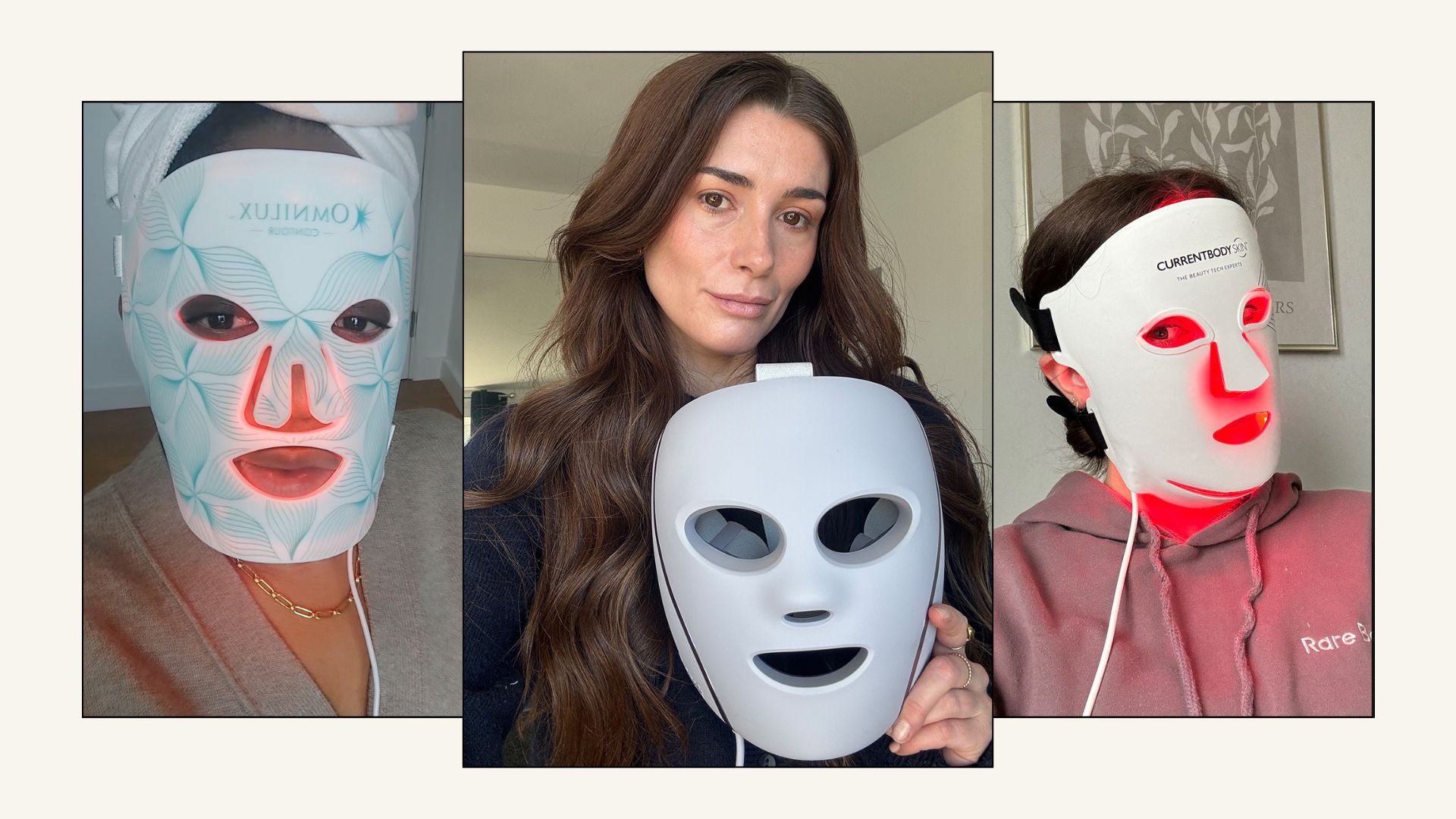
- The Best LED Masks
- What Is an LED Mask?
- How We Tested LED Face Masks
- 1. Currentbody Skin LED Light Therapy Mask: Series 2
- 2. Beauty Pie The Dynamo Deep LED Mask
- 3. Beauty Pie C-Wave Light Facial Dual Light LED Treatment Mask
- 4. Shark CryoGlow LED Mask
- 5. Boots LED Face Mask
- 6. Omnilux Contour Face LED Mask
- 7. Dermalux Flex MD Led Light Therapy Device
- 8. Déesse Pro LED Mask
- 9. Dr Dennis Gross Skincare DRx SpectraLite EyeCare Max Pro Device
- 10. The Light Salon Boost LED Face Mask
- 11. MZ Skin Light-Therapy Golden Facial Treatment Device
- How Does LED Work?
- What Are the Benefits of LED?
- Which Colour Light Is Best for Me?
- Is LED Harmful?
- Why Trust Us

Welcome to Deep Reviews—your one-stop destination to discover the absolute best products and brands the beauty industry has to offer. Every month, our beauty crew and editors will research, test and review the market’s most sought-after and buzzed-about products to see which are truly worth your hard-earned money and attention. You can expect honest, completely uncensored feedback and no-BS recommendations our hard-to-please testers endorse without reservations. To put it simply, stick with us, and buyer’s remorse will be a thing of the past.
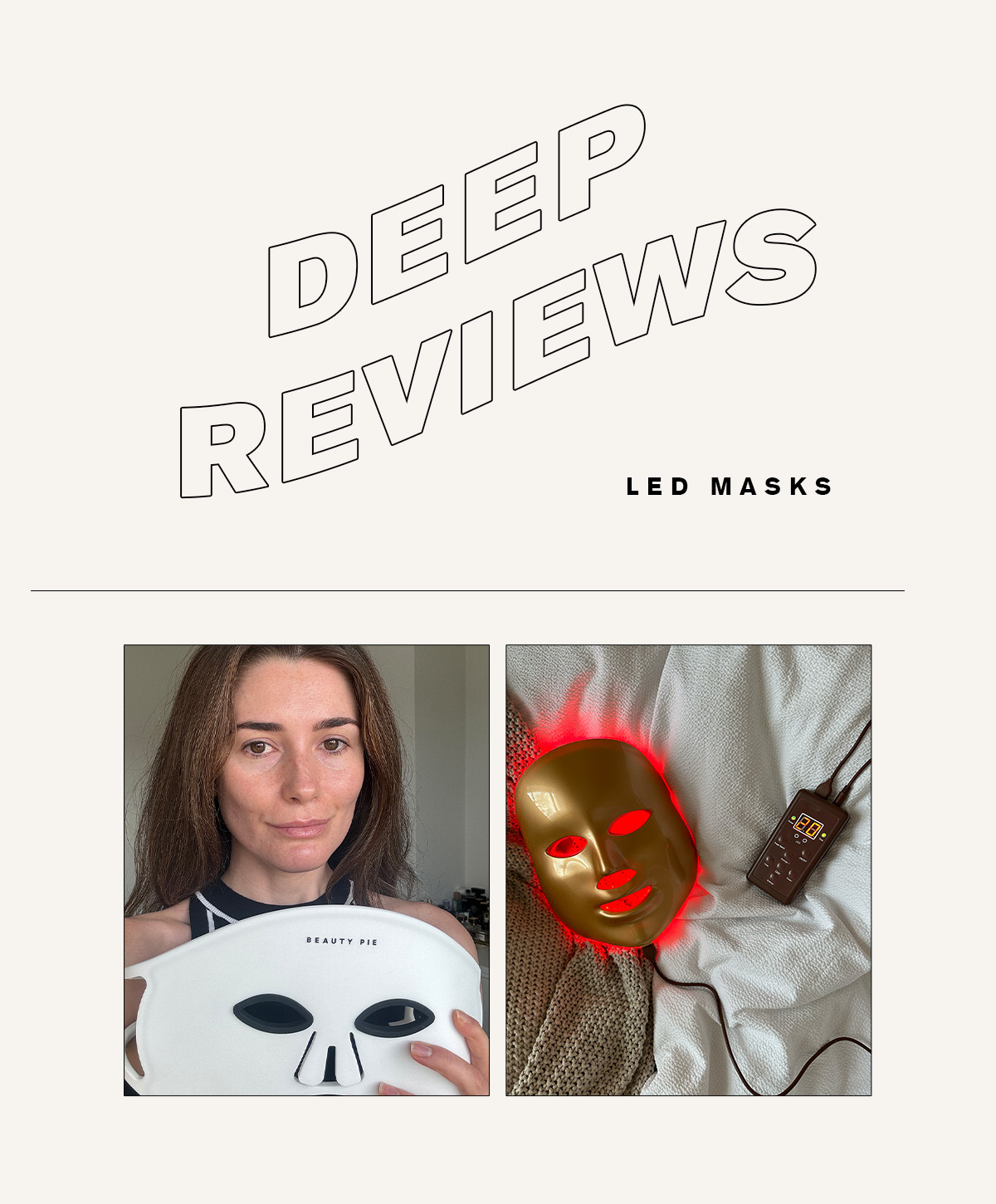
If there's one skincare category that really enthrals theBest Knockoff Luxury Clothing UK team, it has to be skincare tools—most notably, LED masks. We've tested out the best microcurrent devices to sculpt, lift and snatch, and put the best hair multi-stylers to the test. But, for this month's Deep Reviews, we decided to dive deeper into skincare gadgets by testing the best LED face mask devices. That's right, theBest Knockoff Luxury Clothing UK team willingly turned themselves into Iron Man for a full month-long test of the best LED face masks around—we'll do anything in the name of beauty.
The Best LED Masks
- Best Overall LED Mask: Currentbody LED Light Therapy Face Mask: Series 2, £399
- Best LED Mask For Smoothing Texture: Beauty Pie The Dynamo Deep LED Mask, £199
- Best Affordable LED Mask: Beauty Pie C-Wave Light Facial Dual Light LED Treatment Mask, £120
- Best Red and Blue Light LED Mask: Shark CryoGlow LED Mask,£300
- Best Value LED Mask: Boots LED Face Mask, £100
- Best for LED Beginners: Omnilux Contour Face, £351
- Best Investment LED Mask: Dermalux Flex MD LED Light Therapy Device, £2,000
- Best Luxury LED Mask: Déssee Pro LED Mask, £1440
- Best LED Eye Mask: Dr Dennis Gross DRx SpectraLite EyeCare Max Pro Device, £199
- Best Mid-Priced LED Mask: The Light Salon Boost LED Face Mask,£395
- Best For Range of LED Lights: MZ Skin Light-Therapy Golden Facial Treatment Device, £500
What Is an LED Mask?
LED (which stands for "light emitting diode") is a popular facial treatment in clinics, but at-home LED devices allow you to reap the benefits of LED from the comfort of your sofa, ideally while watching The Traitors and scrolling TikTok.
You'll find that there are different lights, called wavelengths, that target specific skin concerns. Blue light, for example, is great at killing off the bacteria that contribute to acne, red light helps to stimulate collagen and treat skin concerns such as pigmentation, whereas near-infrared is ideal for healing and calming inflamed skin. There's a whole spectrum of different wavelengths. Some devices will feature a range of LED wavelengths, whereas others will have more targeted options or offer just one or two options.
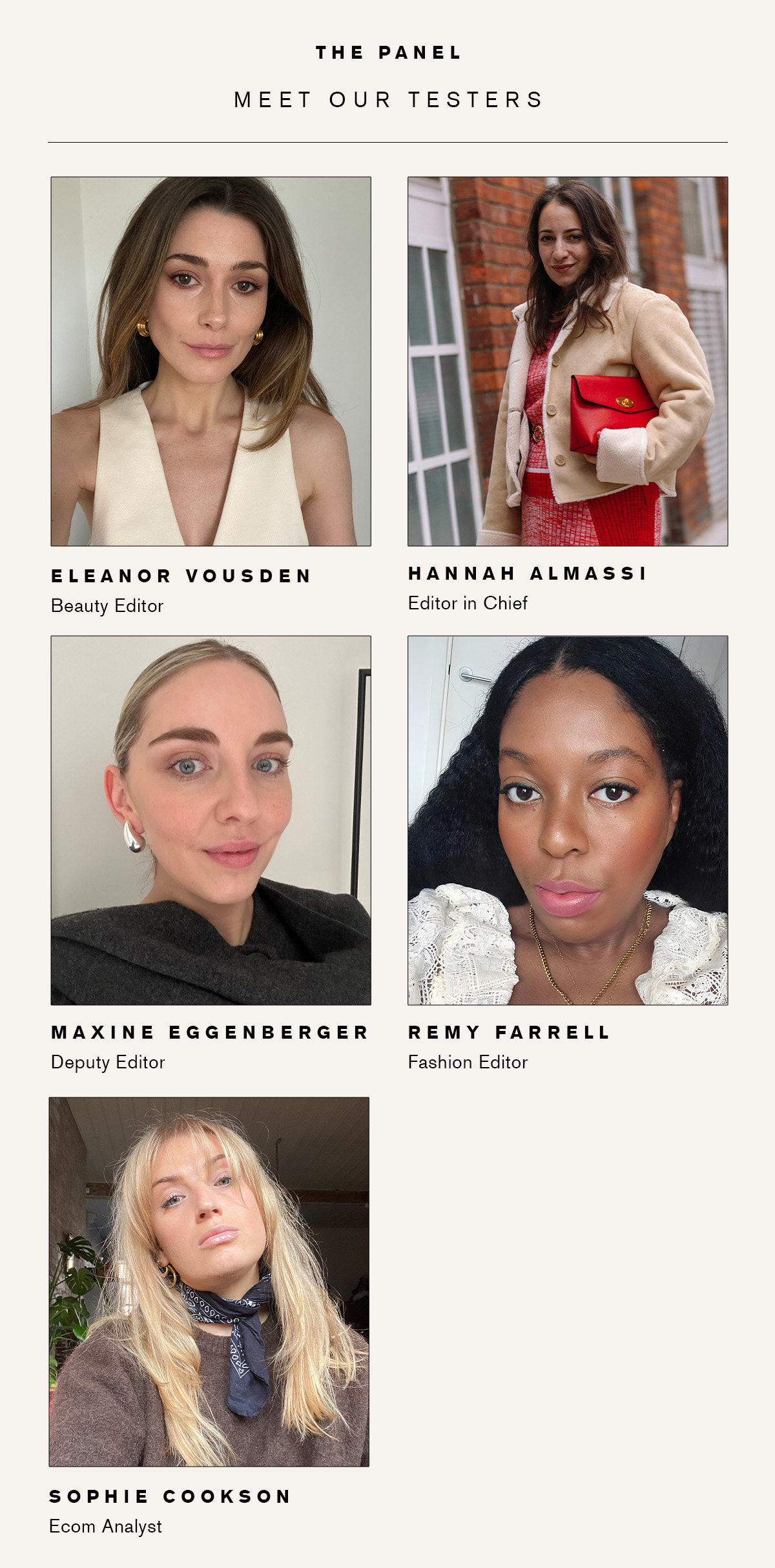
How We Tested LED Face Masks
But let's be honest—LED devices are a big investment. Most start around the £200 mark, but the top-of-the-range ones can easily set you back anywhere between £1000-£2000. So if you're considering buying one, you're probably wondering if at-home LED devices are really worth it. And that's where our Deep Reviews come in. I rallied theBest Knockoff Luxury Clothing UK team to test out the best LED devices on the market right now for at least an entire month, from the most affordable to blow-the-budget face masks. As with all of our Deep Reviews, you'll find us sharing before and after pictures alongside our honest opinions—we don't hold back.
Ready to find the best LED face mask for you? Scroll on for our take on the six different ones we tested.
1. Currentbody Skin LED Light Therapy Mask: Series 2

Pros
- Helps to encourage collagen production to plump, reduce fine lines and wrinkles
- 3 light wavelengths including red, near-infrared and deep near-infrared
- Moulded shape fits facial contours
Cons
- More expensive than original Currentbody LED Mask
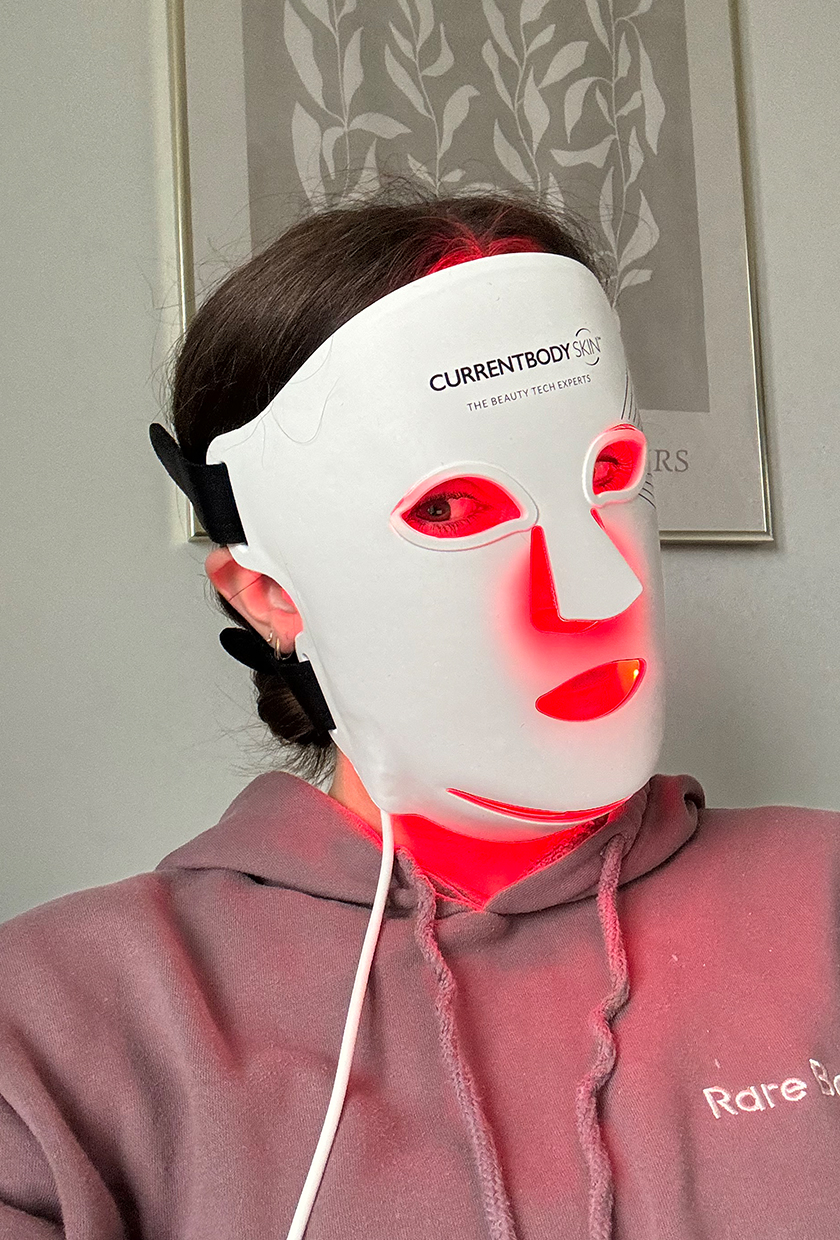
Mask type: Flexible moulded mask, wireless
Treatment time: 10 minutes
Light specs: 3 wavelengths—red (630nm), near infrared (830nm) and deep near-infrared (1072nm)
Rating: 10/10
Our verdict: Alongside Beauty Pie, Currentbody's new and improved LED mask is by far one of the best LED masks out there. In fact, I think it might be my favourite for both the price and its efficacy. I've been reviewing the Currentbody LED Mask for a few months now and it's hard to find anything that I don't like about it.
Before

I used it three times a week and as you can see from my before and after pictures, my skin looks less red and much calmer. The redness from my rosacea is reduced, and the sun-induced pigmentation that reoccurs every summer now look less noticeable. I'm often prone to hormonal acne around my chin and jawline, but I've noticed fewer breakouts since using this LED mask. I've now owned the device for five months and I can notice the results compounding. My skin looks and feels plumper, my skin texture is smoother and my skin is generally a lot better behaved.
This is the new and improved version of Currentbody's LED mask, and one key factor that I think makes all the difference is the fit. Unlike the original (which is a flat flexible mask) this one is made of the same flexible material, but has a moulded shape. This results in a better fit for many people (particularly around the forehead, nose and chin) which also means better results as the mask sits closely to the skin in all areas. I found this LED mask also had the most secure fit of the ones that I tried, without slipping down. I could walk around with it on as I pottered about my flat, and it even stays on during yoga. It's a small detail, but it makes it all the more easier to fit into my busy routine without feeling like I have to sit still, and because it's wired up to a controller with a clip, you can attach it to your clothing and not feel tethered to a plug socket.
After
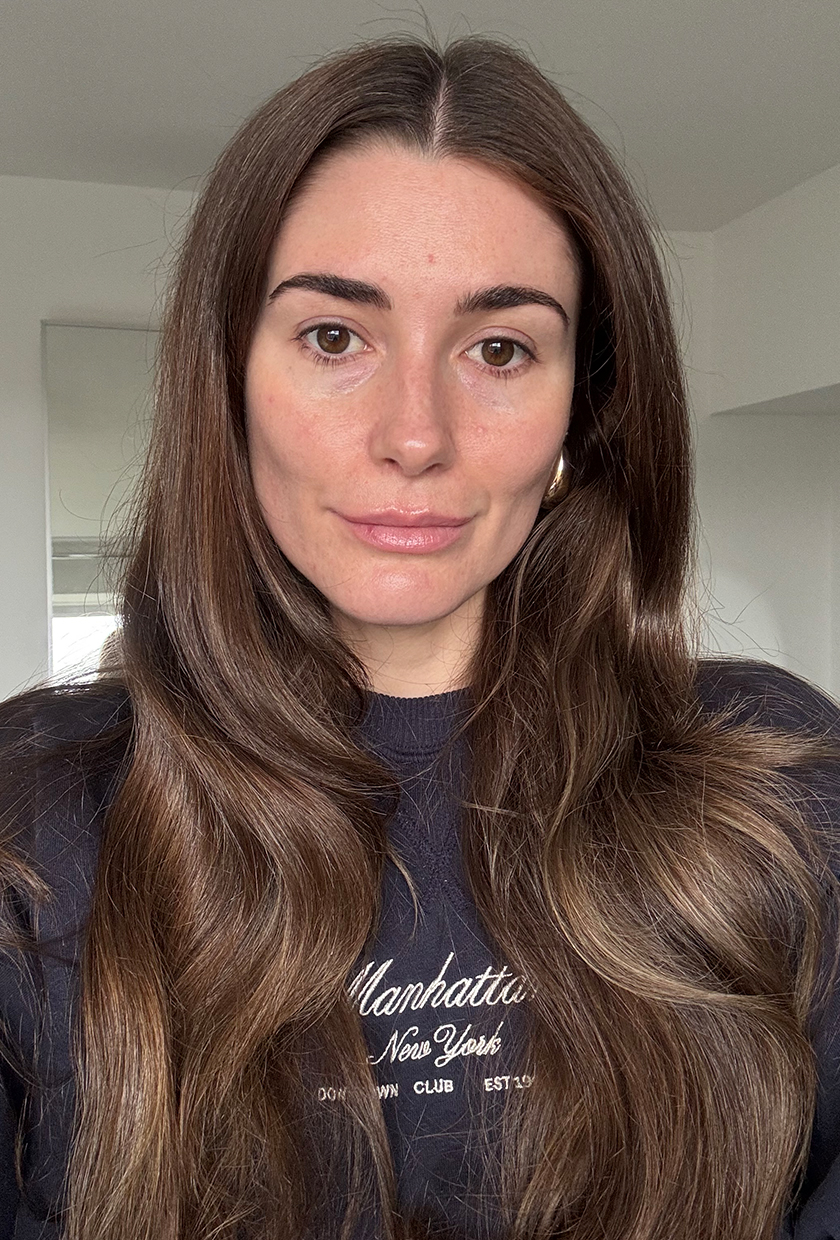
I also think the three different wavelengths give you good value for money. The red light helps to plump fine lines and reduce redness, the near infrared helps to encourage collagen production, while the deep near-infrared goes deeper into the skin to plump deeper-set wrinkles.
While the cost is a little more expensive than the original (and you can certainly get cheaper LED masks out there), I'd say it's a great investment if you're yet to buy an LED mask and want something of high quality for under £500. If you already have the original (or a similar flat LED mask), you may not need it. But if you do want to upgrade, I'd highly recommend this device. Not only is the technology brilliant, but the comfort of the mask actually made me want to use it (and having tested a lot of beauty tools, if they're not comfortable or easy to use, they usually go neglected and unused).
2. Beauty Pie The Dynamo Deep LED Mask
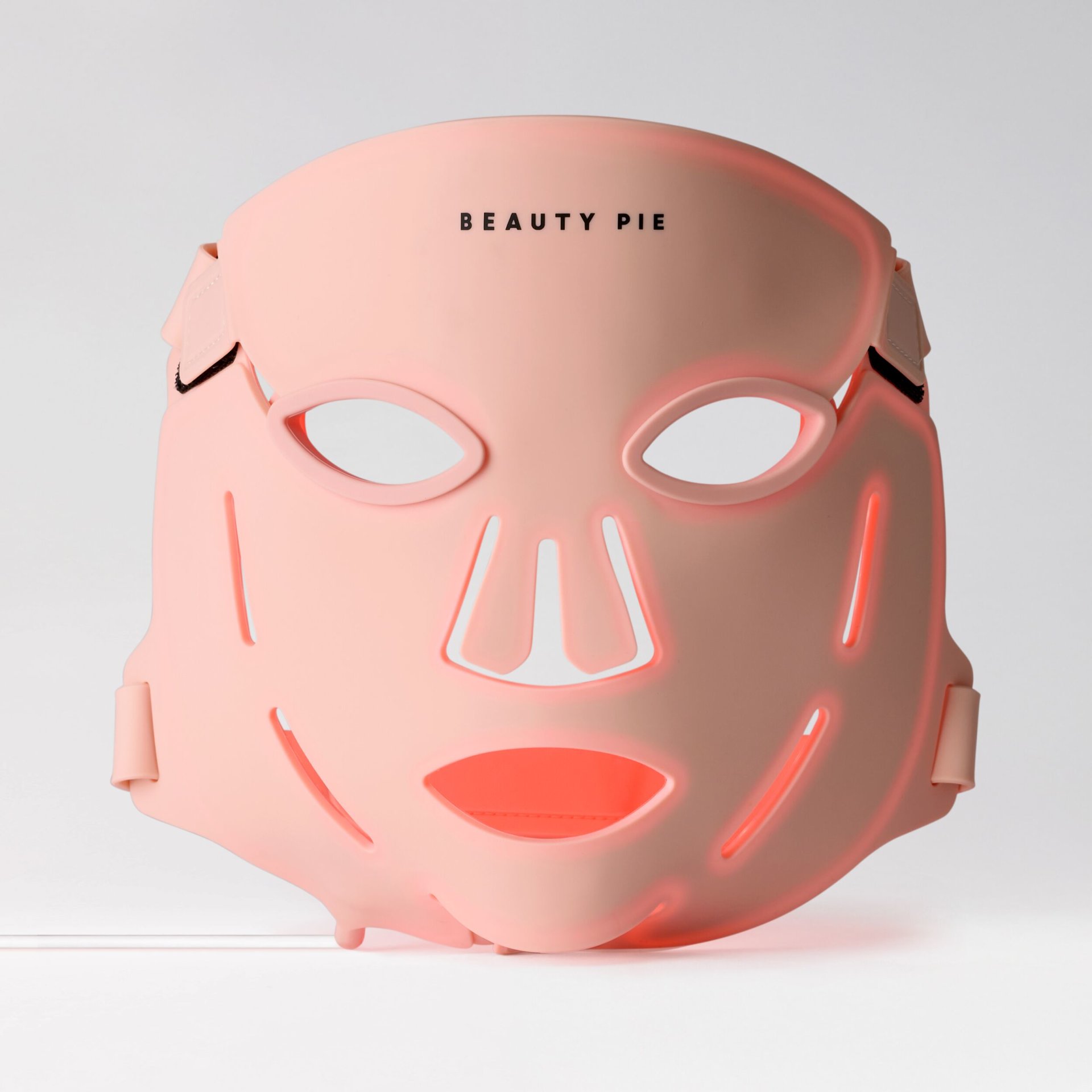
Price shown is member price.
Pros
- Beauty Pie's latest LED mask
- Has red, near-infrared and deep-infrared light
- More affordable compared to other LED masks
- Flexible silicone design
Cons
- Just one treatment mode
- Like all LED masks, it takes time to see results
Mask type: Flexible mask with strap, mains connection
Treatment time: 10 minutes
Light specs: 3 wavelengths—red (630nm), near-infrared (830Nm) and deep near-infrared (1070nm)
Rating: 8/10
Our verdict: Beauty Pie's latest LED mask, The Dynamo Deep LED Collagen-Boosting Mask, stands out in a major way thanks to its triple-wave technology. It doesn’t just offer red and near-infrared light—it also taps into the benefits of deep-infrared light. In fact, it delivers 1070nm of deep-infrared light, which the brand says is clinically proven to be the deepest-penetrating wavelength available in at-home LED devices. Designed to stimulate collagen, plump the skin, boost circulation and calm redness, it’s essentially a professional-level facial packaged into a single, easy-to-use tool.
Before
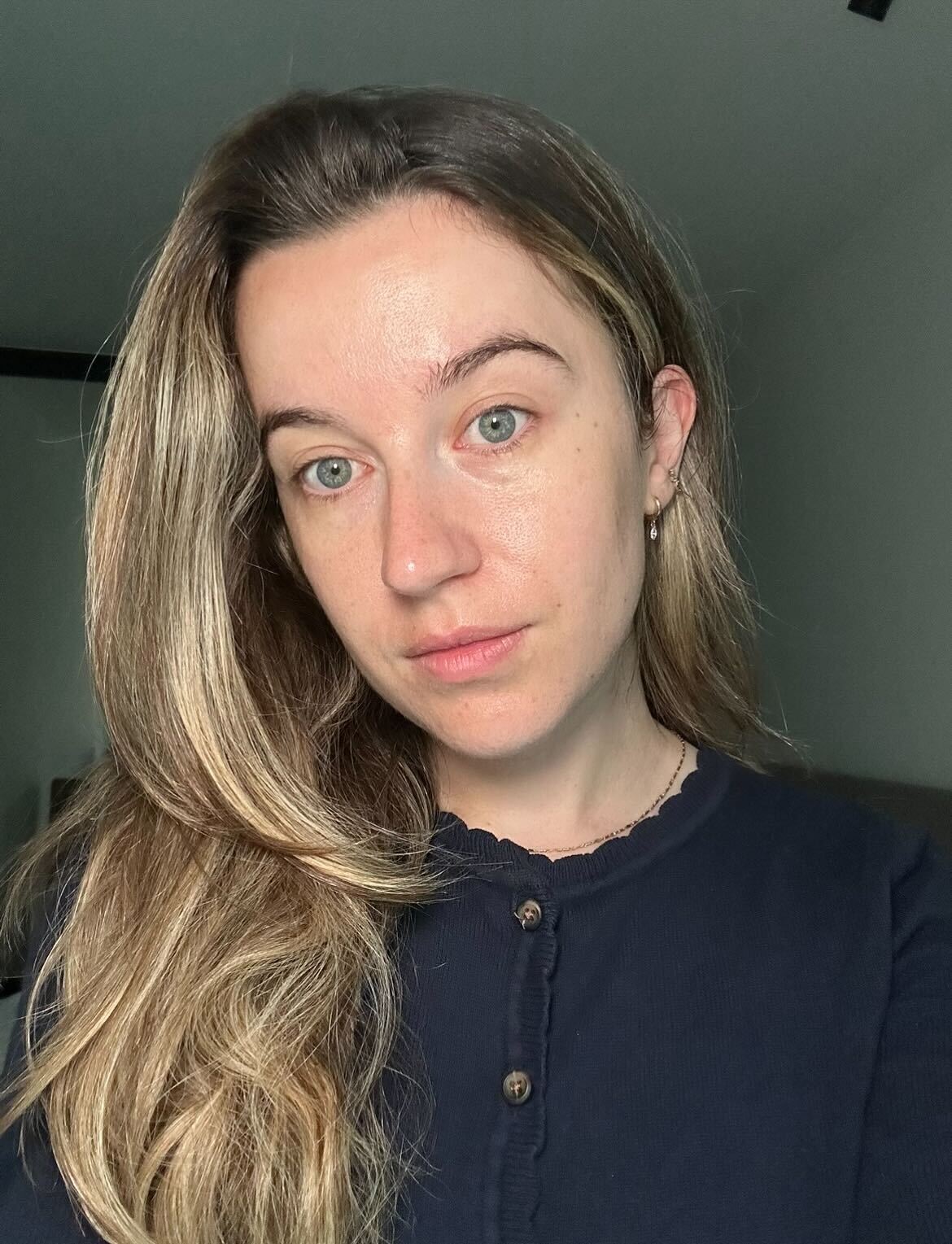
The device has one treatment mode that runs for 10 minutes. For optimal results, the brand suggests using it three to five times a week for at least six weeks. And while some LED masks can feel awkward or heavy, Beauty Pie has created a lightweight, flexible design with two adjustable face straps and a velcro fastening along the bottom so you can tailor the fit to your face. It even includes removable goggles to shield your eyes.
I have to say, I’m genuinely impressed by this LED mask. I’ve tested plenty over the years, and it’s clear how much thought and innovation have gone into this release. When I first opened the box, I was surprised by how luxurious everything felt. The mask comes in a beautiful baby-pink shade, and the box also includes a satin pink travel bag, head straps, goggles, a charger, and a remote to power the mask on and off.
I definitely recommend reading the instructions before your first session, but even without them, the mask feels intuitive and simple to operate. I appreciate that there’s just one treatment setting (it keeps things uncomplicated) and the 10-minute session easily fits into my evening routine. While I’ve never found an LED mask that perfectly matches my facial shape, this one was comfortable to wear thanks to the flexible silicone and adjustable straps. You do have to keep the remote with you if you’re moving around, so I prefer to lie back and enjoy the relaxing treatment, but it’s nice knowing I can walk around if needed.
After
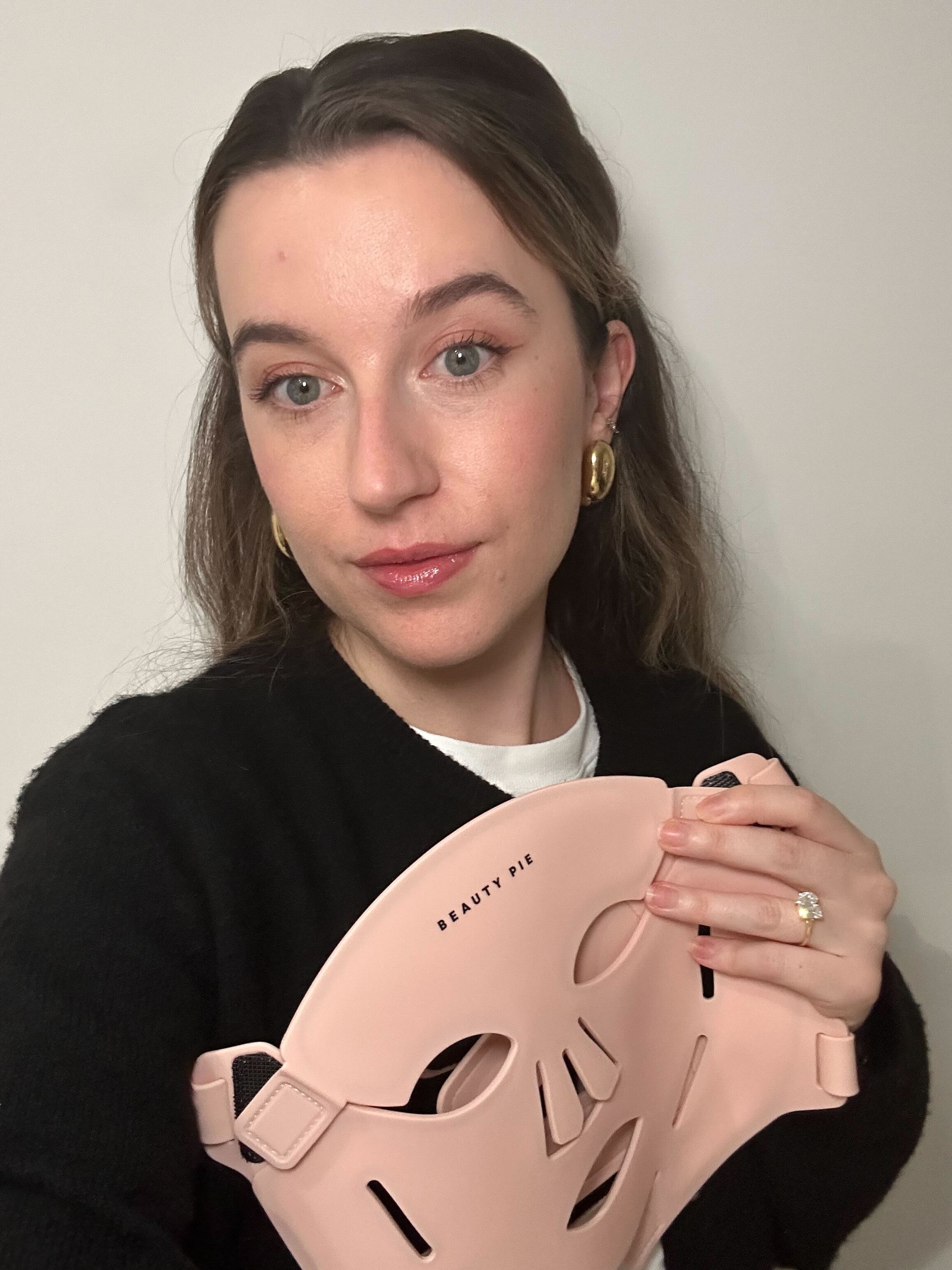
Whilst I haven’t used it long enough to say whether the results are transformative yet, but even after a short period, I’ve even noticed that my skincare applies more smoothly. I’m excited to see how my skin looks in a few months.
You might be wondering how this mask differs from Beauty Pie’s original LED model. The difference comes down to the technology. The original mask is a fantastic option for beginners, but if you want something more advanced, this newer model is the one to choose. The first version uses red light (630nm) and near-infrared light (830nm), while this upgraded mask features red, near-infrared, and deep-infrared wavelengths, targeting deeper layers of the skin for enhanced results.
While the original mask is priced at £120 for Beauty Pie members, this updated model costs £199. Considering the level of technology involved, I think that’s exceptional value. With many LED masks now starting at £400 and up, I have no doubt this more affordable option is going to be popular.
3. Beauty Pie C-Wave Light Facial Dual Light LED Treatment Mask
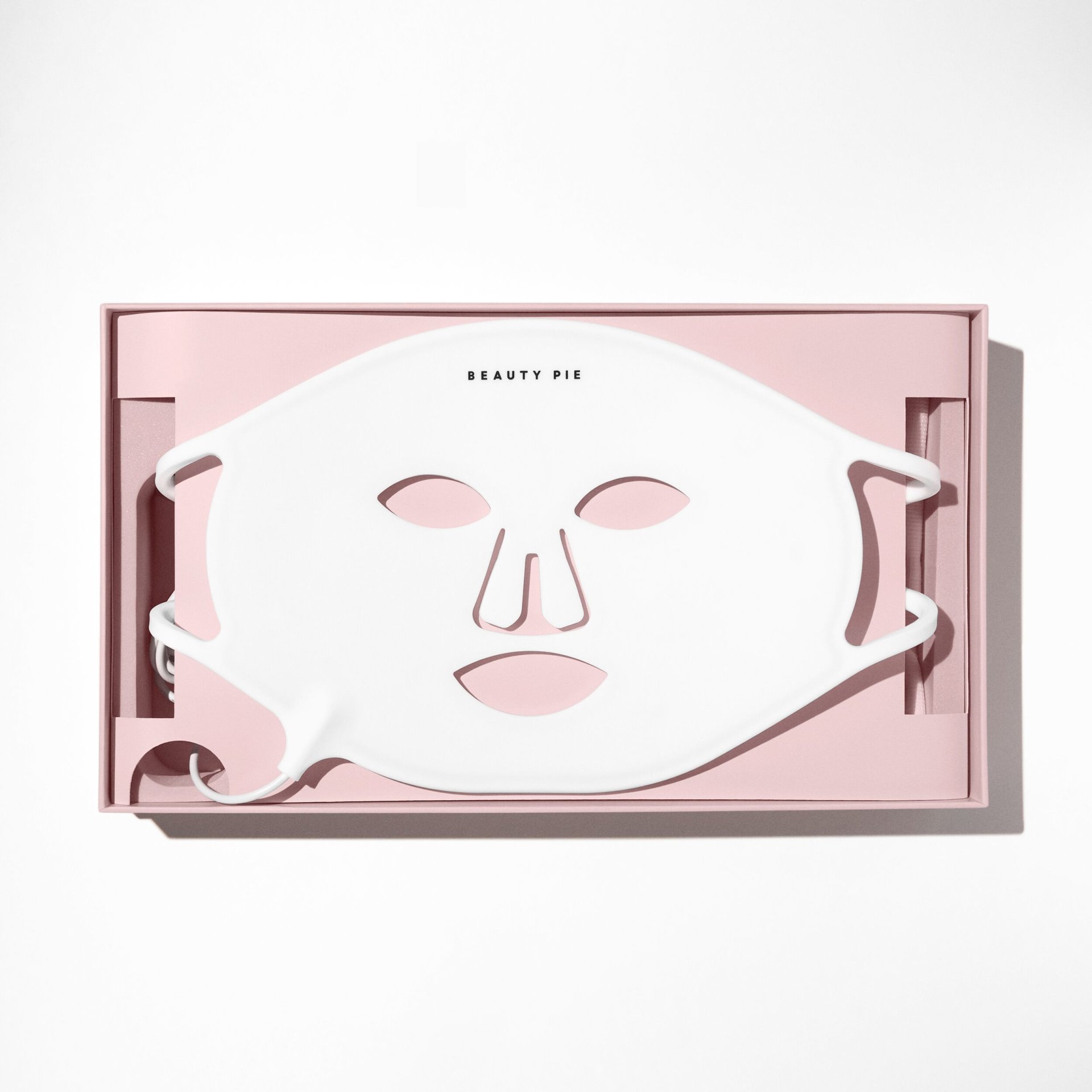
Price shown is members' price.
Pros
- Helps to boost collagen production to plump fine lines and wrinkles and leave skin glowing
- One of the more affordable LED masks out there that doesn't compromise on results
- Flexible shape moulds to face
Cons
- You need a membership to access member prices
- Some find the fit isn't as snug on some areas of the face
- Goggle inserts can leave indents after use
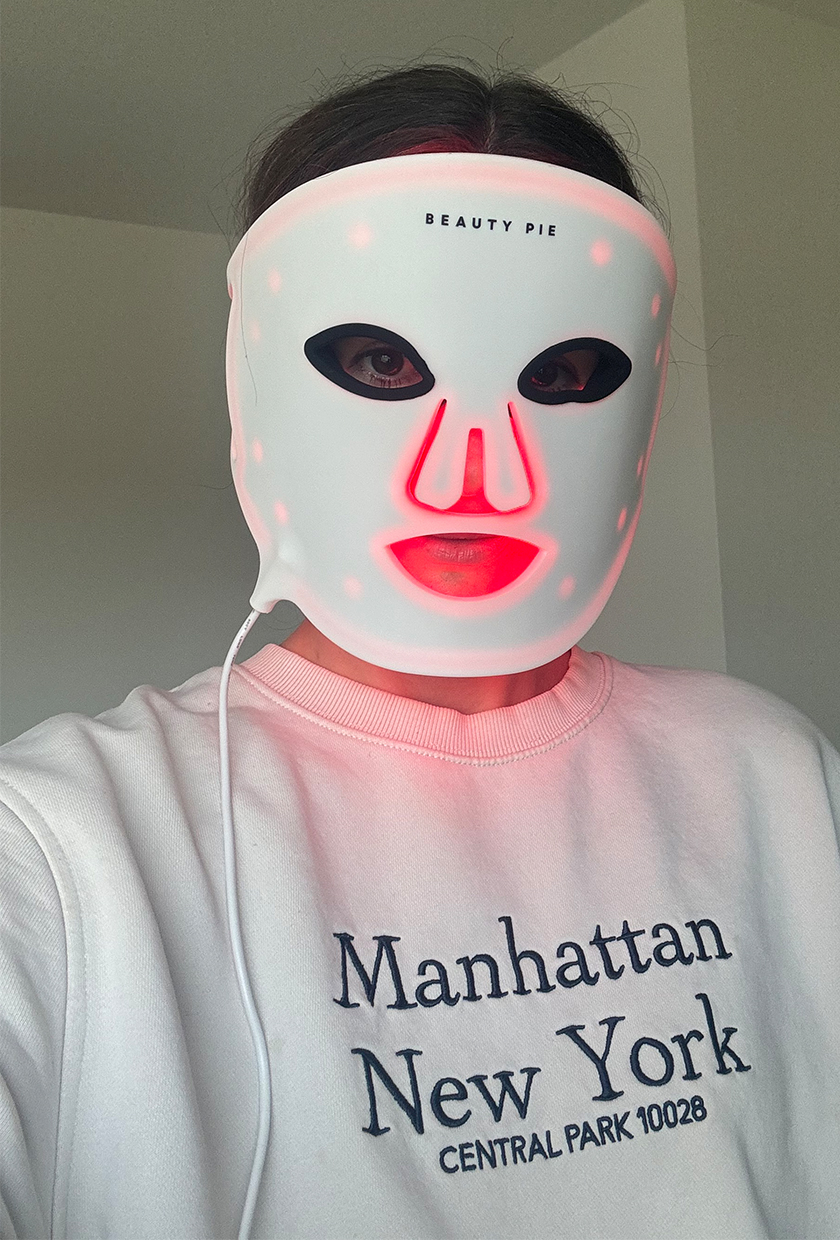
Mask type: Flexible mask, wireless
Treatment time: 10 minutes
Light specs: 2 wavelengths—red (630nm) and near infrared (830nm)
Rating: 9/10
Our verdict: Since reviewing the original Beauty Pie LED Mask, it's become one of the hardest-working parts of my skincare routine. And looking back on my before and after pictures below, I can really see the benefits in my skin from using it regularly. Beauty Pie's LED mask is hugely popular (it's sold out multiple times now), so if you see it in stock, it's a good time to secure one. The member price makes it one of the most affordable LED masks out there, and even if you're not a member, the £250 non-member cost still rivals the price of many of the LED masks that we've tested in this story.
Before
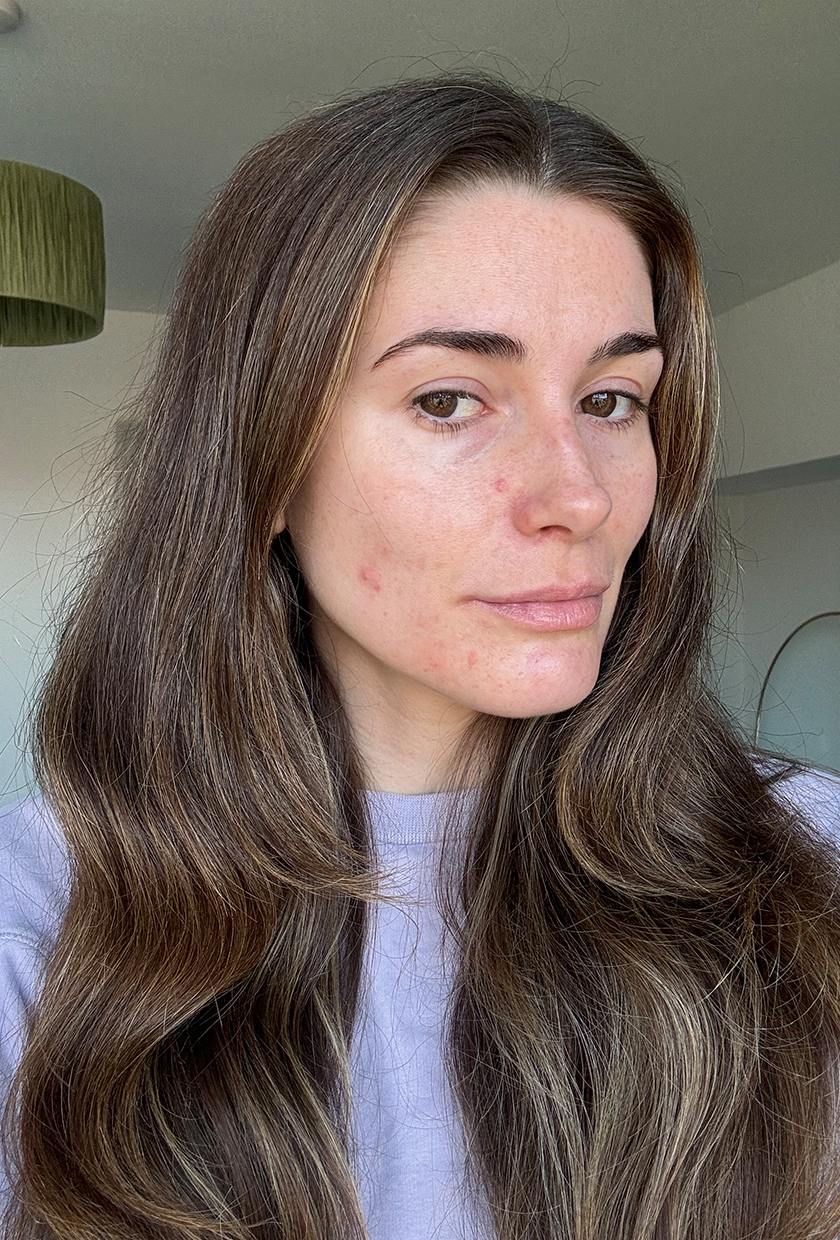
I used the mask around four times per week, and I noticed a visible difference in my skin. My redness and acne scarring had reduced, my skin possessed more of a glow and the fine lines around my eyes had softened. Result! The mask is made of a flexible material that can be moulded around your face. While it personally gave me a close fit to my skin (bar a little gap around my forehead), I did find the velcro not the most secure and found it slipped down if I decided to wear it while walking around. But, most of the time I used this while lying down anyway, so it wasn't a huge issue, but something to bear in mind if you want to potter about while doing your treatments. It's also wireless, so you don't feel tethered to a plug socket while wearing it. Instead, it's powered by a controller that you can charge up. A full charge gave me around six 10-minute treatments.
Featuring both red and near-infrared light, I think this is a really high-quality LED mask for the price tag. And having tried a lot of expensive LED masks out there, I think this certainly rivals many of them. The 10-minute treatment time is the perfect amount to easily slot into my routine, and I actually found it a great way to wind down in the evenings.
After

The results were subtle at first, but really compounded over the weeks with consistent use. During testing, I headed away on a warm holiday and caught the sun, which had caused some pigmentation. However, the mask really helped to fade it. My skin has also had fewer breakouts and seems calmer generally, so I can vouch for the healing effects of the near-infrared light. In fact, after having an allergic reaction to a body lotion on my chest, I used the mask on it, and I could see a visible improvement in the redness after just 10 minutes.
With many masks around costing anywhere between £300-£1k+, the £120 price tag of this mask is very appealing, especially as it doesn't compromise on quality. I love that the mask is really easy to use—just press a button, sit back and relax for 10 minutes. I do wish that the velcro straps could provide a more secure hold, and I find that the goggle inserts can leave indents on my skin for a few minutes afterwards, but it's something I can overlook for the cost and results. If you're looking for an affordable yet effective mask that helps to reduce wrinkles, pigmentation and redness, I'd highly recommend you try it.
4. Shark CryoGlow LED Mask
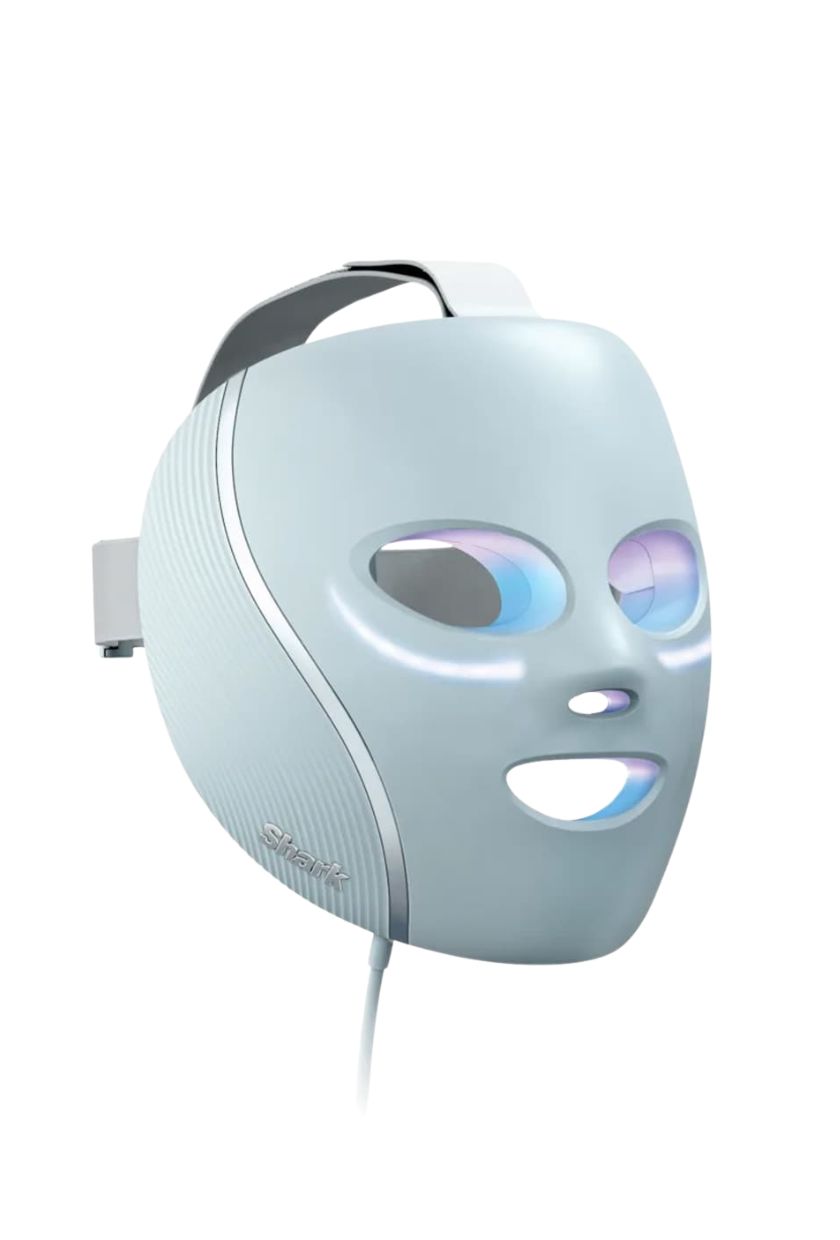
Pros
- Choice between red light and blue light treatments
- Built-in cyrotherapy eye masks to cool and de-puff the eye area
- Helps to encourage collagen production and heal breakouts
- Easy and simple to use
- Treatments are quick, so it's easy to fit into your routine
Cons
- Quite bulky to store
- Cooling fans are noisy when in use

Mask type: Moulded LED mask with cooling under-eye masks built-in
Treatment time: 4-15 minutes
Light specs: 3 wavelengths—blue (415nm), red (630nm) and near-infrared (830nm), plus 3 cooling under-eye cryotherapy settings
Rating: 9/10
Our verdict: When I first received the Shark CryoGlow LED Mask, I couldn't wait to try it. This is the only LED mask that not only features both red and blue light treatments, but also has the addition of cooling under-eye masks built into the mask to help cool and de-puff the eye area. And they really work. You have the option to turn them on or off while you're experiencing the LED light to reap the benefits of both technologies.
Before
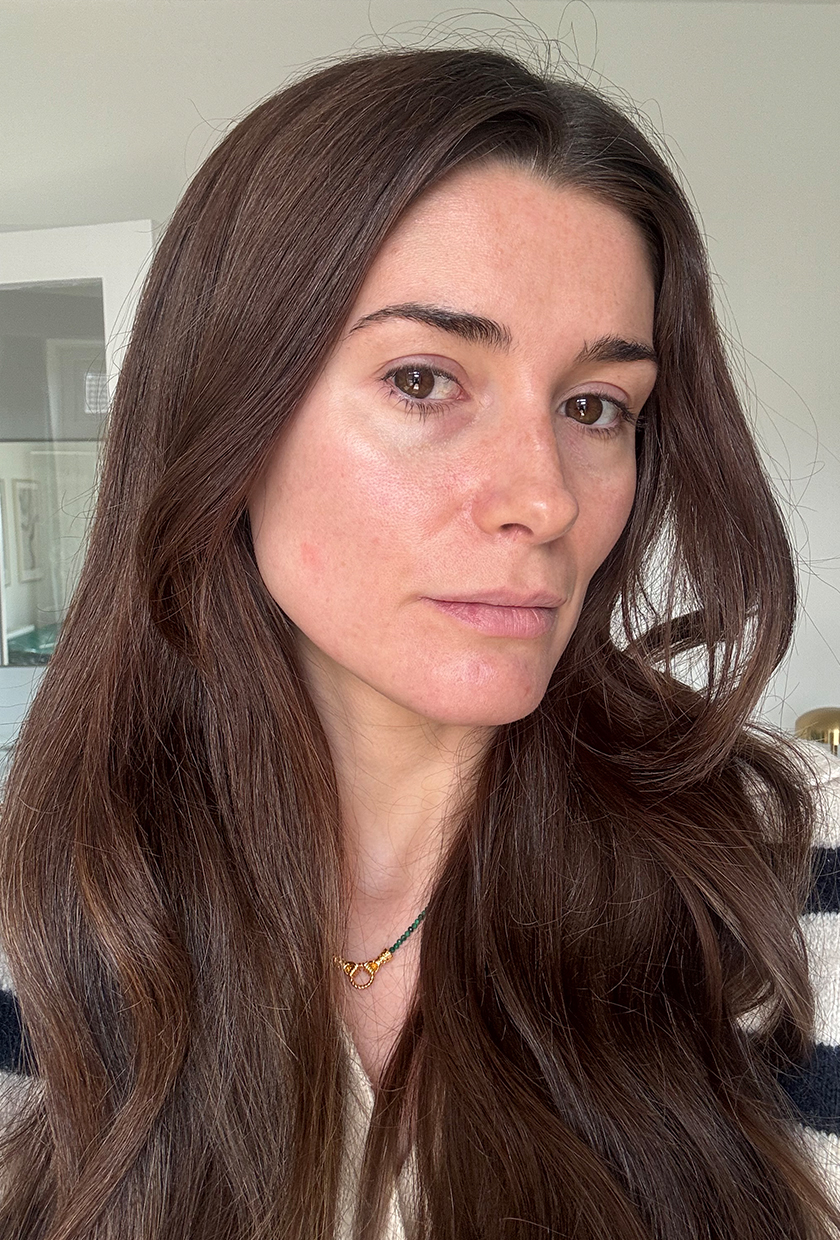
As for the LED, you have four treatments to choose from. The "Better Ageing" mode uses red and near-infrared lights to boost collagen production, while the "Blemish Repair" mode uses blue light to soothe and treat blemishes. Then, you have the "Skin Sustain" mode, a 4-minute treatment designed to maintain results. You also have the option to use the cryotherapy under-eye mask as a standalone treatment without the LED if you wish.
For my review, I mostly used the "Better Ageing" routine to help fade pigmentation and plump fine lines. I noticed results around the first month of use; my skin was glowier, more even-toned and smoother around my eyes. What I really love is how quick the treatments are. The main treatments are 6-8 minutes, so it feels easy to slot into even the busiest of routines. It's actually a really good way to double up with a quick meditation, and Shark has created its own playlist to help you unwind at the same time.
After
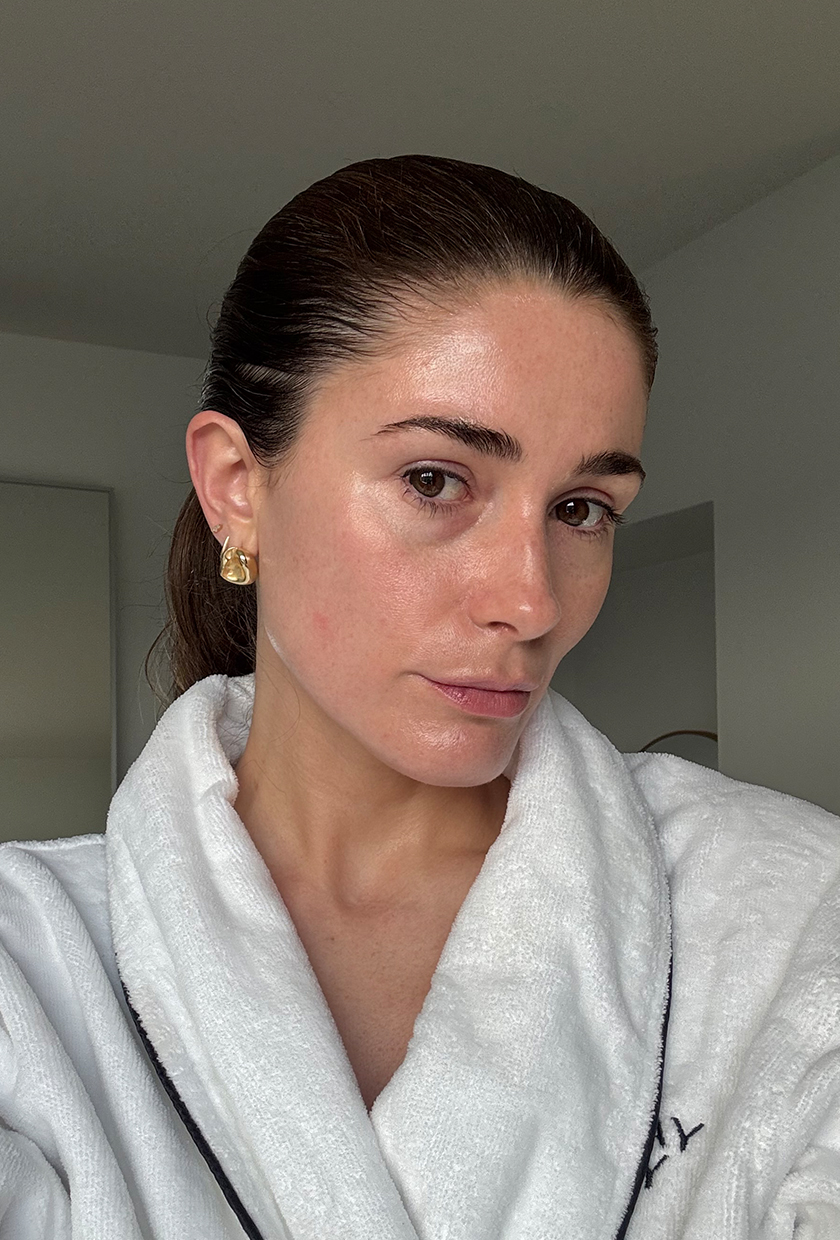
The treatments are accessed through the remote, which is connected to the device, so it's easy to scroll through and select the one you want. It also has a clip, so you don't have to lie down while using this mask—you can go about your day without feeling tethered to a plug socket. It also keeps tabs on your progress and how many sessions you have completed of each treatment, which is a nice touch to keep track.
If I had to nit-pick, I'd say that the fans are quite noisy when the cooling under-eye masks are in use, but it's a small price to pay. Their addition is a welcome touch to treat the under-eyes while enjoying all the benefits of the LED, too. It makes the price feel like a reasonable investment.
5. Boots LED Face Mask
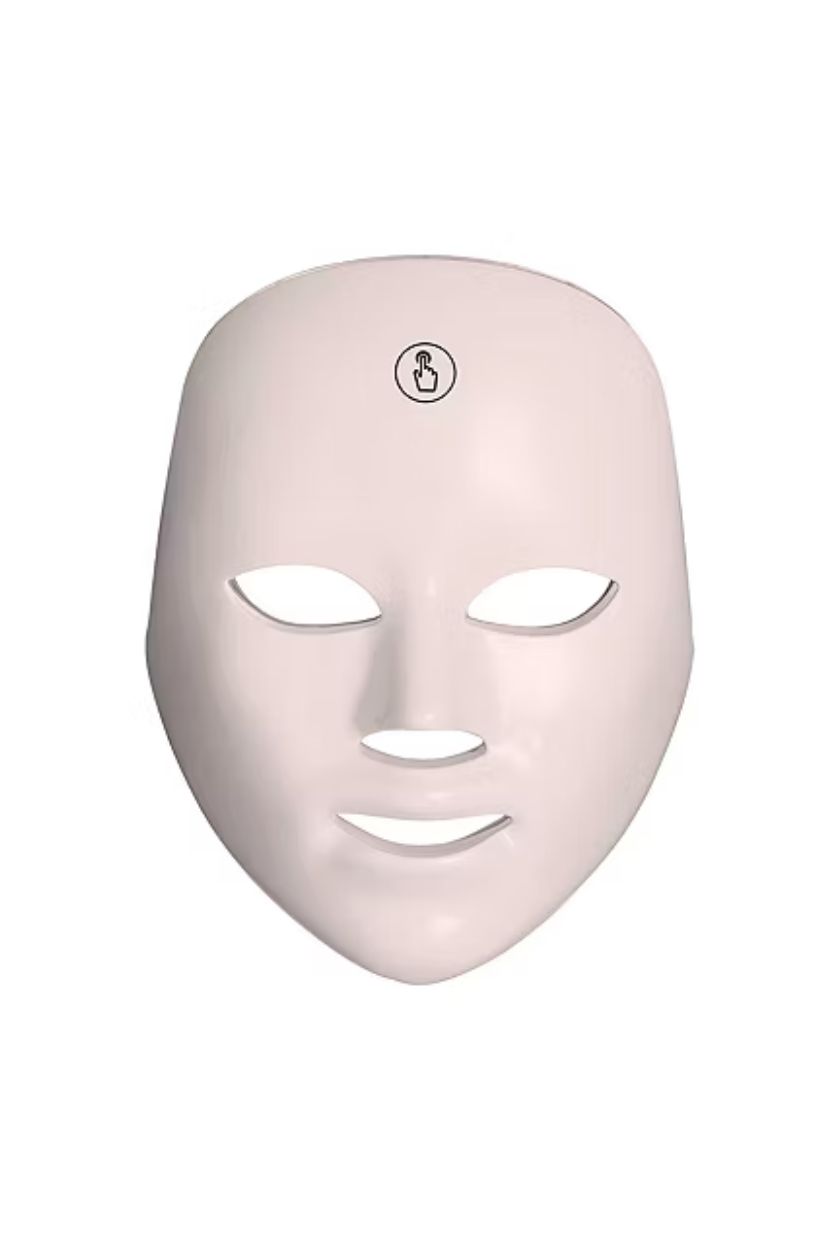
Pros
- Great range of four different wavelengths
- One of the more affordable LED masks we tested
Cons
- Mask is rigid and can be uncomfortable
Mask type: Moulded mask with strap, mains connection
Treatment time: 15 minutes
Light specs: 4 wavelengths—red, yellow, green and purple
Rating: 8/10
Our verdict: What’s brilliant about this Boots LED Mask (and genuinely impressive given the price) is that it offers four different LED treatment modes to address a wide variety of skincare concerns. Naturally, there’s a red mode to help promote smoother-looking skin, but it also includes a yellow mode for radiance, a green mode for balance and a purple mode to help minimise the appearance of pores.
Before

Unlike many LED masks made from flexible silicone, this one has a more structured design. It comes with a convenient head strap, and the best part is that you only need to press a single button on the top of the mask to switch it on, meaning you can move around freely instead of holding a remote. Inside the box, you’ll find the mask, a USB charging cable, the strap and an instruction manual.
The brand suggests using the mask for 15 minutes a day, four times a week, so it’s easy to slot into your routine. You’ll want to use it after cleansing and drying your skin, before applying any serums or moisturiser. Hold the ON/OFF button for three seconds to power up the device, then press the same button to toggle through the different LED modes.
So, what did I think of this mask? Honestly, I’m very impressed. But before I get into why I love it, let me touch on the downsides. Because of the rigid design, it’s not quite as comfortable as other masks I’ve tried. That said, the fact that it’s completely hands-free is a huge benefit. The only other slight drawback for me was the 15-minute treatment time. It’s a bit longer than some other masks I’ve tested, but in the grand scheme of things, it’s hardly an inconvenience for glowing skin.
After

Now, onto the pros. Firstly, £100 for a skincare device like this is pretty exceptional, especially considering it offers four different treatment modes. I’ve tried plenty of pricier devices that only include one or two, so I couldn’t believe it when I saw how many light options this one provides. It’s ideal if you’re looking for a mask that can target a broader range of concerns.
The other thing I loved? How incredibly easy it is to use. I will say the button isn’t always the most responsive (I sometimes have to press it a couple of times), but the fact that everything is controlled from this single button makes it wonderfully straightforward for anyone new to LED masks.
I’ve been using it for a few weeks now, and I’ve already seen some subtle improvements in my skin. My complexion looks brighter and more even, and the scarring from a previous breakout is fading little by little each week. I definitely need to continue using it to see more dramatic changes, but so far, it’s an easy win from me.
6. Omnilux Contour Face LED Mask
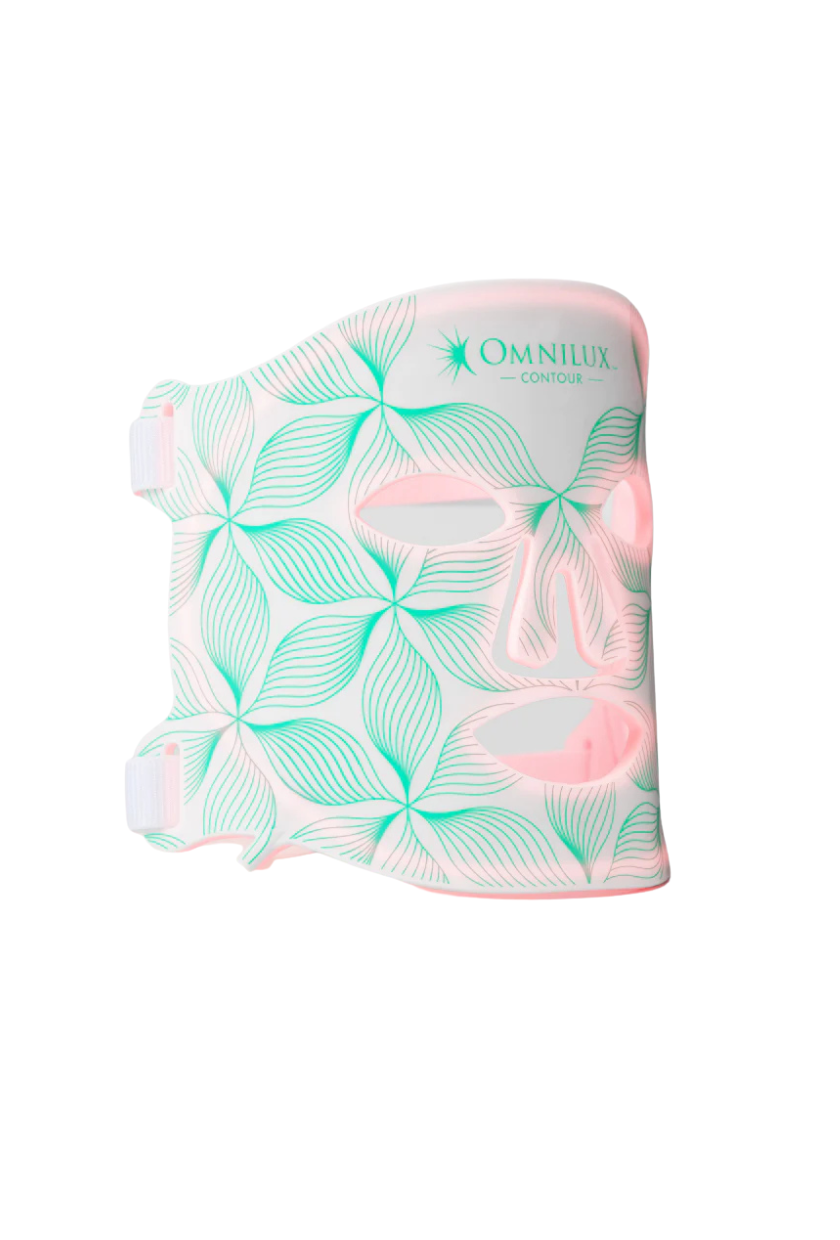
Pros
- Helps to plump fine lines and wrinkles
- Red and near-infrared light
- Easy to use
Cons
- Eye holes can be a little uncomfortable for some
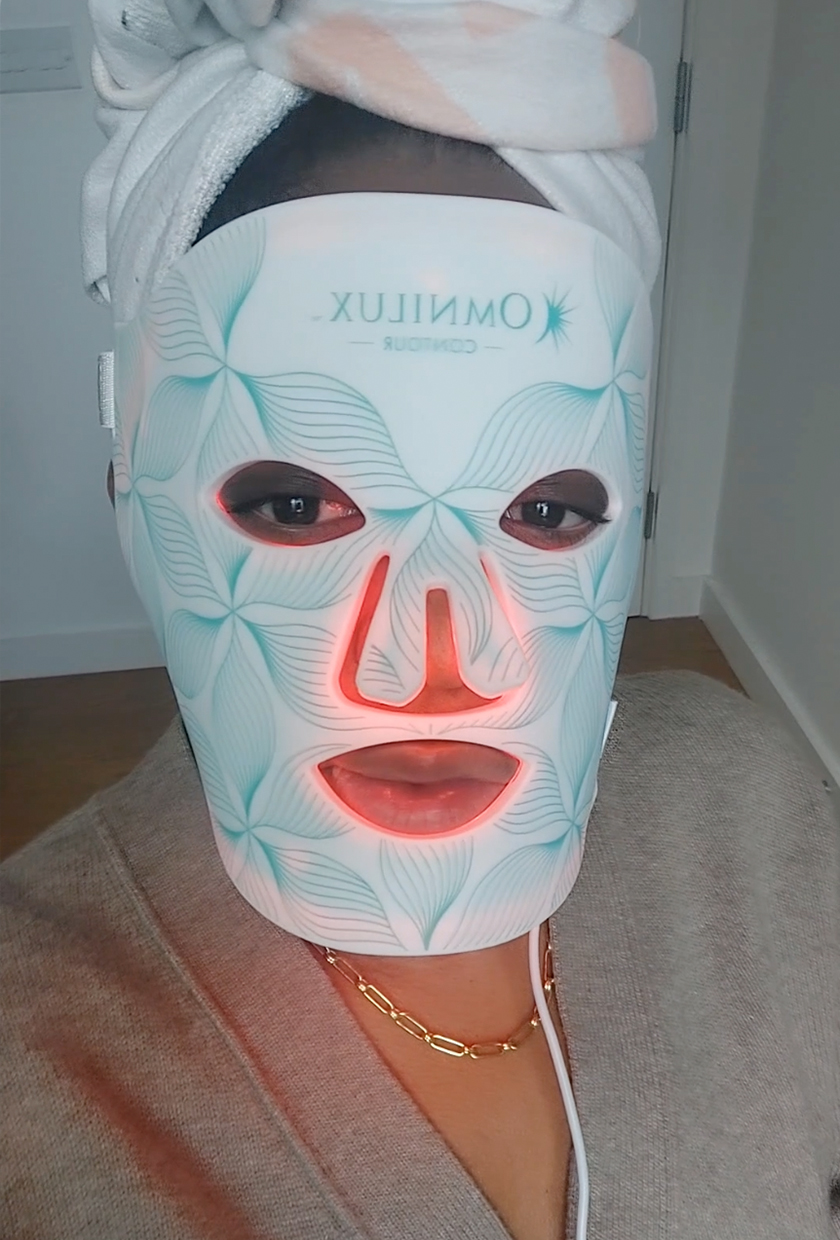
Mask type: Flexible mask, wireless
Treatment time: 10 minutes
Light specs: 2 wavelengths—(red 633nm and near-infrared 830nm)
Rating: 7/10
Our verdict: I have to admit that I was immediately taken in by the concept of the LED mask. Some of the best facials I’ve ever had have incorporated light therapy, so the bar is immediately set high for any at-home devices to perform in quite the same way that a salon facial does, but what piques my interest in the Omnilux Contour is the promise of medical-grade LEDs. So far, so good.
Before
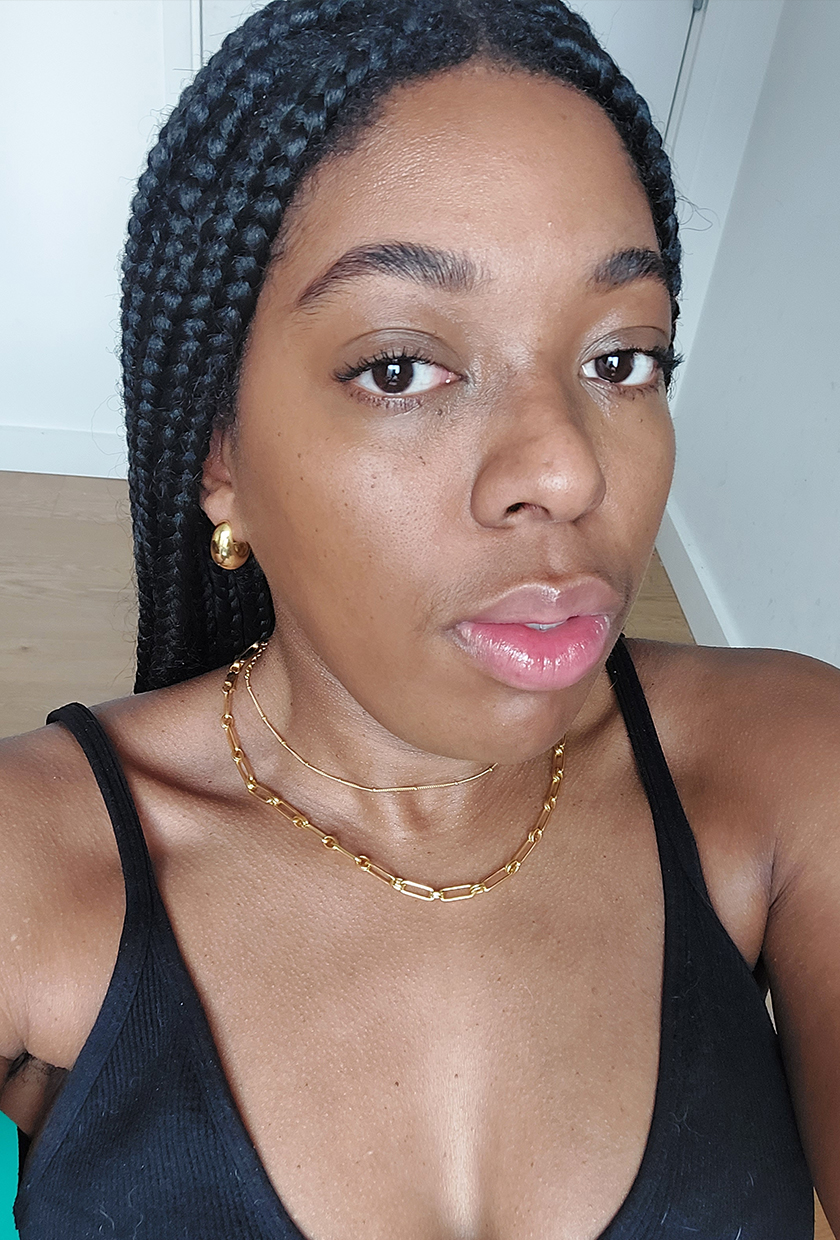
Setting it up and switching it on couldn’t be easier (even for a technophobe like myself), so when I say that it's just a case of plugging in to the control and pressing down to turn it on, it really is exactly that. There are no other functions or settings to have to get to grips with, just one, red light, 10-minute treatment that I start by using four or so times a week, and as it’s so gentle, there’s no heat or strange sensations, just the feeling of a flexible rubber mask.
After using the device for the first time, I didn’t expect to see much (and I didn’t), but by the third or so use, I am surprised by what I feel. Starting out, I’m aware that one of the primary functions of this mask in particular is to reduce the appearance of fine lines and wrinkles, and while that isn’t a focus of mine, after the first couple of uses, my skin feels noticeably softer. Aside from the mask, my skincare routine hasn’t changed dramatically, but the skin that had been quite dry and rough before is surprisingly smooth, and the change in texture is a total surprise.
After the results of the first few uses, I consistently used the mask to see what other changes I could pick up on, but I predict that most LED masks need a longer trial period over the course of a few months to give skin time to properly adjust, and the Omnilux Contour is no exception. I don’t see much change in the uneven skin tone that I wanted to correct, but I am really happy with how my skin feels and in turn, how my makeup sits. As I’m used to having dry skin I tend to load up on serums and gel creams to create a smoother, "glass skin” look (and so my foundation doesn’t end up lasting the day), but during the course of this trial period I’ve scaled back on the amount of products and been both surprised and impressed by just how good my make up still looks at the end of day. Flaky, rough, blemished skin—gone.
This device is the perfect piece of kit for anyone starting out who doesn’t want to have to connect to apps, adjust settings or sit uncomfortably for long periods of time, and the mask’s flexible nature is one of its better features, as it bends to adjust to the shape of your face.
After

My first attempt at getting into the mask took a little bit of time (and if anything, I could do with slightly larger eye holes for comfort), but when lying back with your eyes closed, the mask is light and easy, and with no harsh glare. The only issue I came across was the aforementioned eye holes, but again, if you can take out the 10 minutes to put your feet up with your eyes closed, it’s probably a better experience than trying to factor it into an on-the-go routine.
There isn’t a lot to dislike about the mask; it’s more a case of choosing the right treatment for you. Some masks target acne, others reduce redness and inflammation, and the contour specialises in fine lines and wrinkles, and while I don’t see much difference in how "young” my skin looks, it could well be the case that the improvement in texture is proof of the collagen-boosting properties of the red light treatment working.
All masks are relatively pricey given the technology involved, so although you might initially baulk at the price compared to a sheet mask or a facial, it’s worth investing in a piece of kit that you can use time and again from the comfort of your own home. In comparison to other masks on the market, the Omnilux Contour strikes the right balance between being more affordable than leading competitors and being reassuringly priced.
7. Dermalux Flex MD Led Light Therapy Device
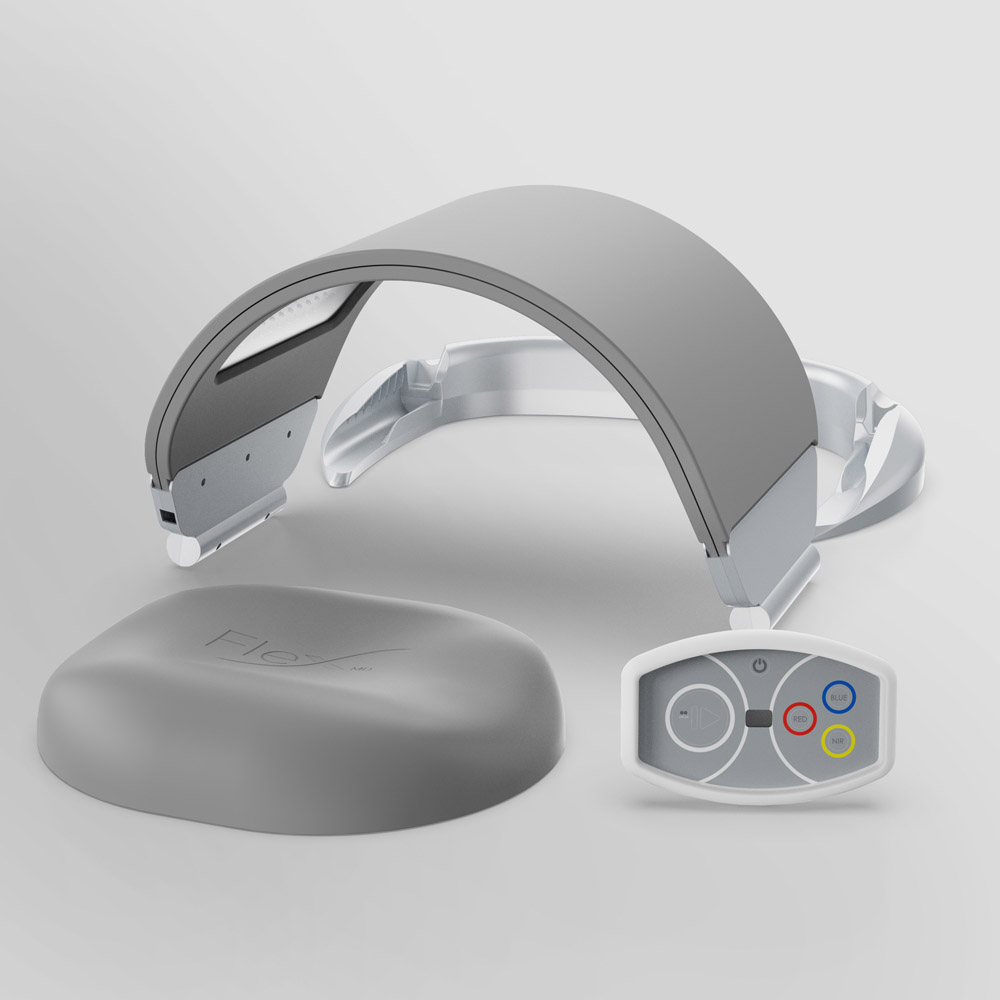
Pros
- Clinical-grade LED wavelengths and results
- Includes red, blue and infrared
- Helps to encourage collagen production, reduce breakouts and fine lines and wrinkles
- Can be used both on the face and areas of the body
Cons
- Very expensive
- May be too bulky for at-home use
- 30 minute treatment times can be too long
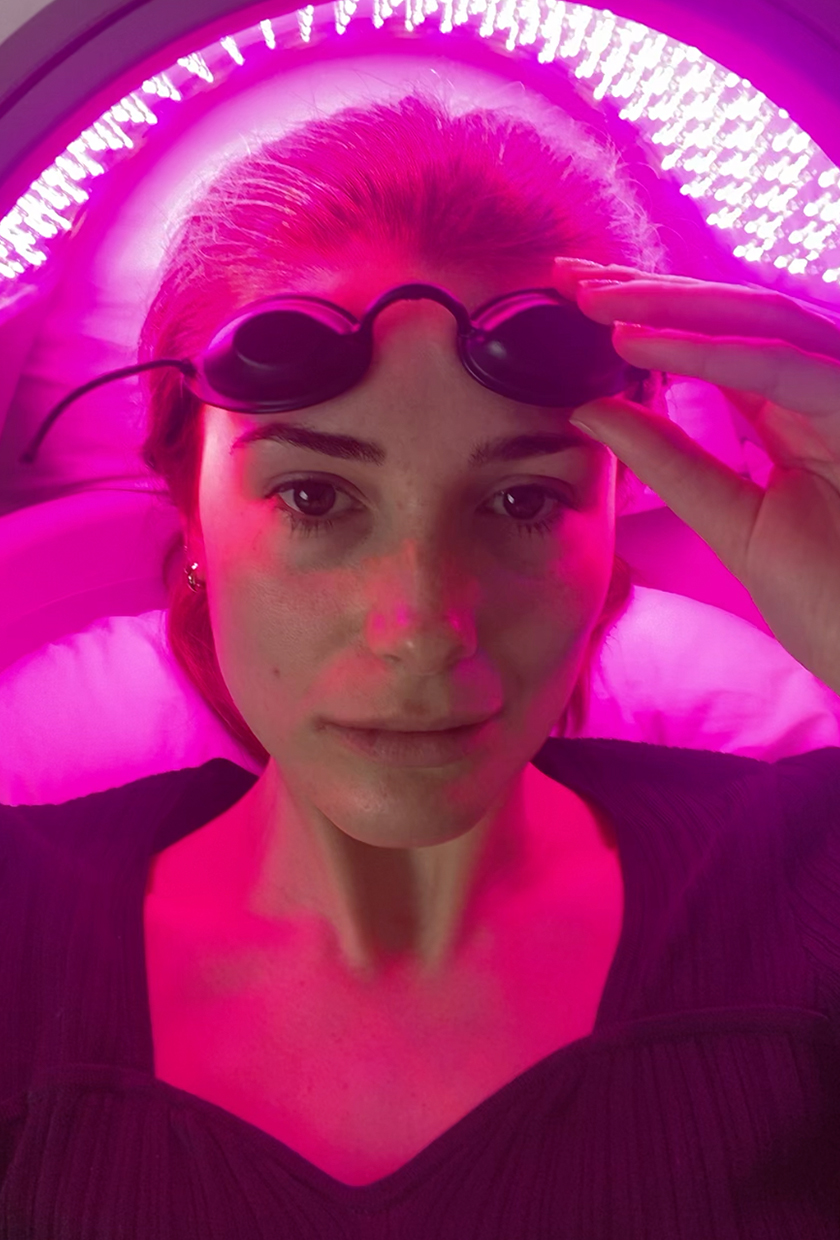
Mask type: Flexible LED panel, mains connection
Treatment time: 30 minutes
Light specs: 3 wavelengths—blue (415nm), red (633nm) and near-infrared (830nm)
Rating: 8/10
Our verdict: The Dermalux Flex MD LED Light Therapy Device is probably the closest thing you can get to having a professional LED treatment at home, and that’s what contributes to the large price tag. Professionals use this in-clinic on their clients to treat a whole range of concerns, from acne to eczema and psoriasis to boosting collagen, both on the face and the body. It can even address joint and muscle pain and wound healing, which makes it very versatile. The LED lights sit on a flexible panel, which means you can remove them from the base to use on both the face and the body. This is particularly useful if you experience back acne, eczema or psoriasis on your body, as you can simply place the panel over the area.
Before
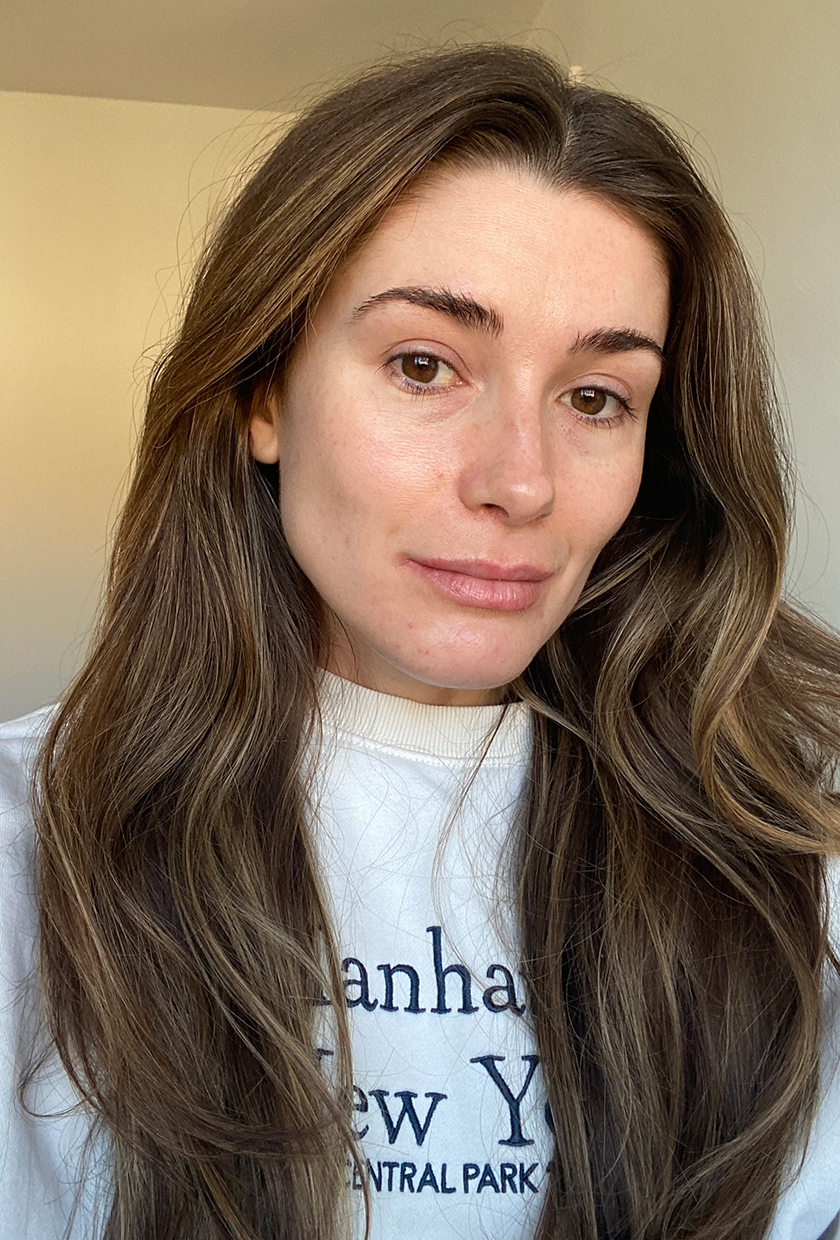
The device comes with an array of different light treatments (but not so many that it's overwhelming), which you can mix and match for a tailored treatment via the control panel, which is very easy to use. Simply press which LED option(s) you want, pop on your safety goggles and press start. Then all you have to do is lie back and relax while the lights do all the hard work. Even with the goggles, the light feels very bright, which takes some getting used to, but I actually found the treatment really warming and relaxing—like taking a nap in the sun, but with none of the UV damage and all the skin-rejuvenating effects of LED.
The device also comes with a pillow, which is a nice touch, but I preferred just using my own, which was more comfortable. It also comes with a booklet with a guide on what LED light combinations are best to treat different skin concerns. I would mention that the near-infrared setting looks almost invisible in daylight—I actually emailed the brand PR because I was worried this setting wasn’t working properly! But rest assured, the light is there and does work very well, particularly on areas of inflammation.I love the versatility of the device and the fact that it can be used both on the face and body, thanks to the flexible LED panel. I liked being able to customise my treatments, choosing just the one light wavelength to treat a specific concern, or combining them to treat multiple problems.
When trying the device for the first time, I decided to combine all three light wavelengths: red, blue and infrared. Red helps to boost collagen and target pigmentation, blue treats acne, while infrared helps to reduce inflammation and encourage healing. After emerging from my 30-minute treatment, I didn’t notice a huge difference, but my skin had a little more ‘glow’ and looked less inflamed. I also used the device on my hands, which were experiencing an eczema flare, and it had definitely become less inflamed over the following days. But the real results came after testing for a couple of weeks.
After

After using the device two/three times a week for a full month, I noticed that my pigmentation had subsided, and my skin looked more radiant. The results felt quite subtle, but I’d also had more compliments on my skin than ever before when using this device. On the final day of testing (and when I took my after photo above), hormonal acne struck my chin, and the beginnings of an eczema flare were on the horizon. I think it’s important to remember that no product will fully cure or prevent a skin concern, but this certainly helps with the treatment and management. Spots and redness were kept very much at bay while using this, and the ones that struck at the end of my treatment trial subsided much quicker than they usually would on their own. The eczema on my hands, while still there, is much calmer than it was, too.
The only thing I can really fault with the device is the size. This was originally designed for in-clinic use, of course, so it is on the larger size, and it's not necessarily a negative thing, but I found that it took up a lot of space in my flat. It does come with a bag to store it in, but as I wanted to use it regularly, it was easier to leave it assembled rather than packing it away each time. And if I had to nit-pick, I found the 30-minute treatments tricky to weave into my routine. Unlike the other wearable LED face masks that we tested, you can’t potter around while using this one, and wearing the goggles is a must to protect your eyes. That said, it’s a great excuse to lie back and relax with a podcast.
Of course, I can't ignore the price tag. This is an eye-wateringly expensive piece of equipment. However, if you're someone who regularly has and benefits from in-clinic LED devices, and you want to reap the benefits at home, the investment may well pay off. Plus, this is probably the closest thing you can get to an in-clinic LED treatment, so you know it's going to deliver good results.
8. Déesse Pro LED Mask
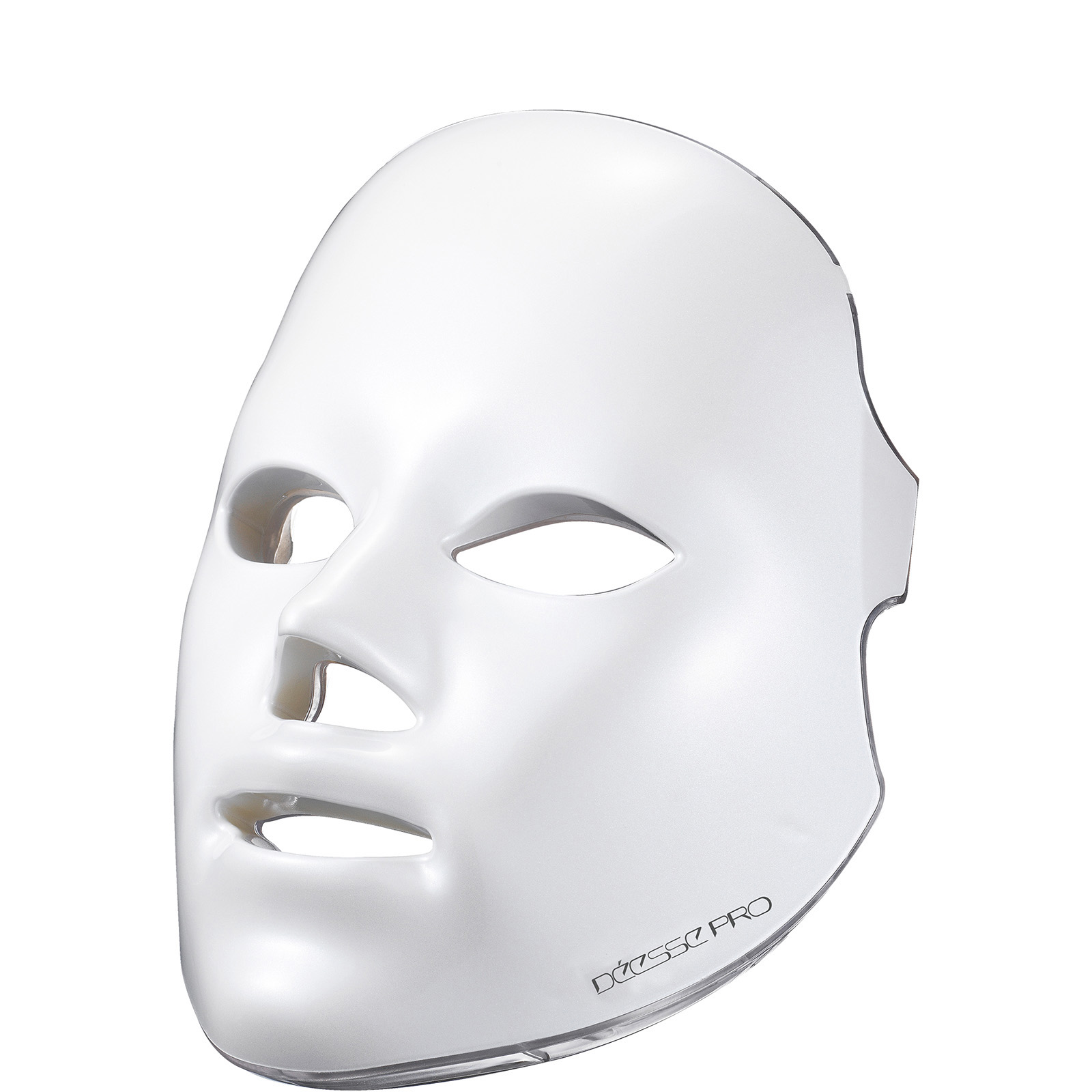
Pros
- Includes 4 wavelengths, including red, blue, green and near-infrared
- Helps to increase collagen production, calm irritation, reduce acne breakouts and brighten the skin
- Multiple treatment options and times
Cons
- Very expensive
- Plastic mould doesn't give a comfortable fit for everyone
- Needs to be plugged into mains to be used
Mask type: Moulded plastic mask with strap, mains connection
Treatment time: 20-60 minutes
Light specs: 4 wavelengths—red (630nm), blue (415nm), green (520nm) and near-infrared (830Nm)
Rating: 7/10
Our verdict: The Déssee Pro is the one you’ve seen all over Instagram—it is a market leader and a top contender in the world of premium LED masks, considering it comes in at a cool £1440. Yes, it makes you look a little bit like Jason from Halloween. Yes, it terrified my husband, child and cat. However, when it comes loaded with endorsements from Hollywood celebrities, influencers I trust, skin experts and makeup artists alike, I was absolutely willing to risk scaring my household in the name of better-looking skin.
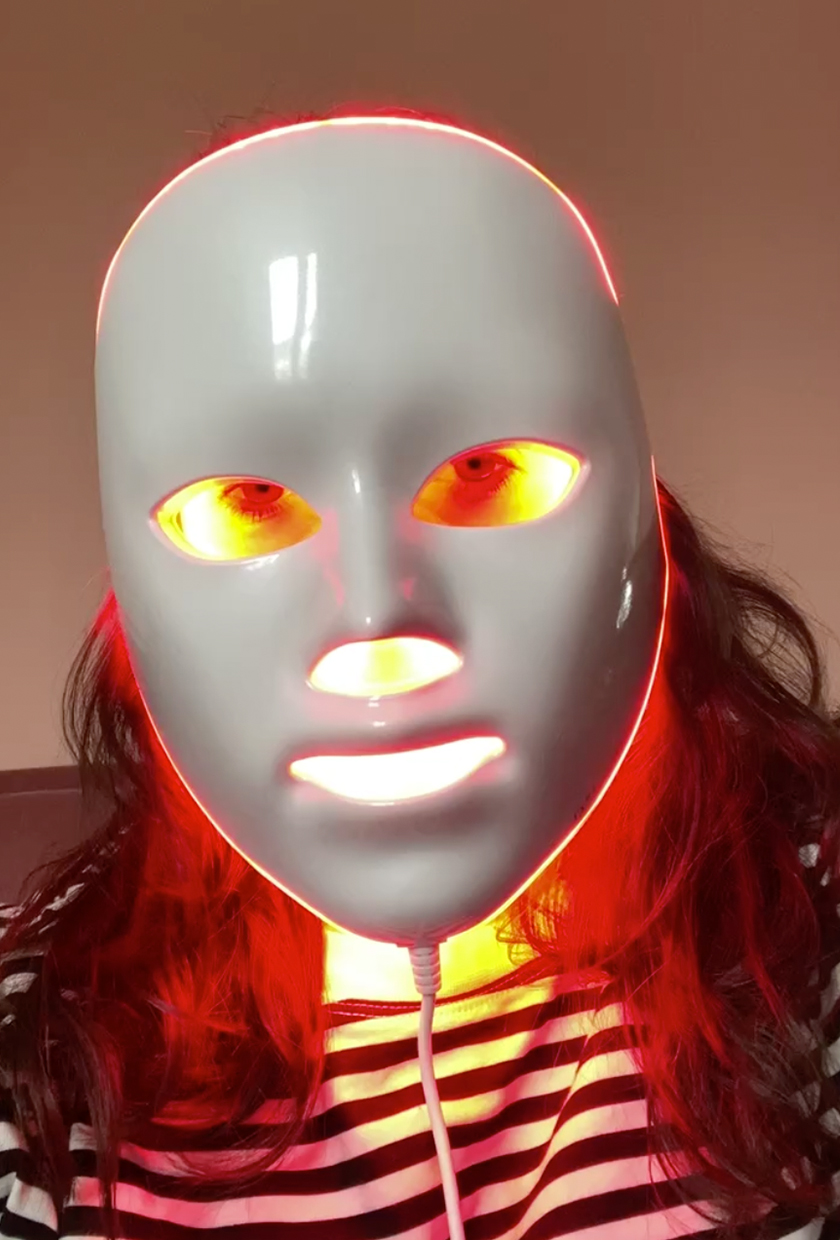
There are six separate treatment modes using a multitude of wavelengths to combat different concerns such as anti-ageing, evening pigmentation and calming down breakouts—I like having options, so this already spoke to me. Once you’re over the first hurdle of reading the instructions (isn’t it hard to be patient?), the device is ultra-easy to use. I liked that you can combine different modes into one session, depending on where your skin is at on any given day. It’s simple to plug in, select the mode you want and simply hit go. There is a timer that ensures even the sleepiest of beauty lovers won’t fall into a slumber and have LED lights on their face for several hours, which is just as well, as this is a nice ritual to do before bedtime.
I’m not sure if there are any LED devices that work on a one-treatment and you’re done kind of basis, but I would say that the acne treatment mode (that’s using blue light—number two on the mode list) was effective much faster than I would’ve imagined. I have been suffering over the past month or so with some digestion issues after picking up multiple stomach bugs, which manifested as some irritating little breakouts. If I used it before bed, I would find that by the morning, the breakout had calmed significantly—the Déssee Pro helped clear the breakouts up quicker than any spot treatment I’ve used before.
My impression of LED masks is that this is a gradual top-up one sees the benefits from over time rather than in the space of a month, so although I do think the Déssee Pro has done some good work to help boost some collagen for my wrinkles and smooth out my skin-tone, I think it’s one of those magically subtle tools that you’ll miss the most once you’re not using it. I’m sure that if one had the money to spend £1.4k on a bit of beauty tech you might want to see more dramatic results instantly, but if you consider this to be a constant treatment that you’d use rather than going to a salon, it could be more valuable over time as a reliable strategy for maintaining your skin.
Before
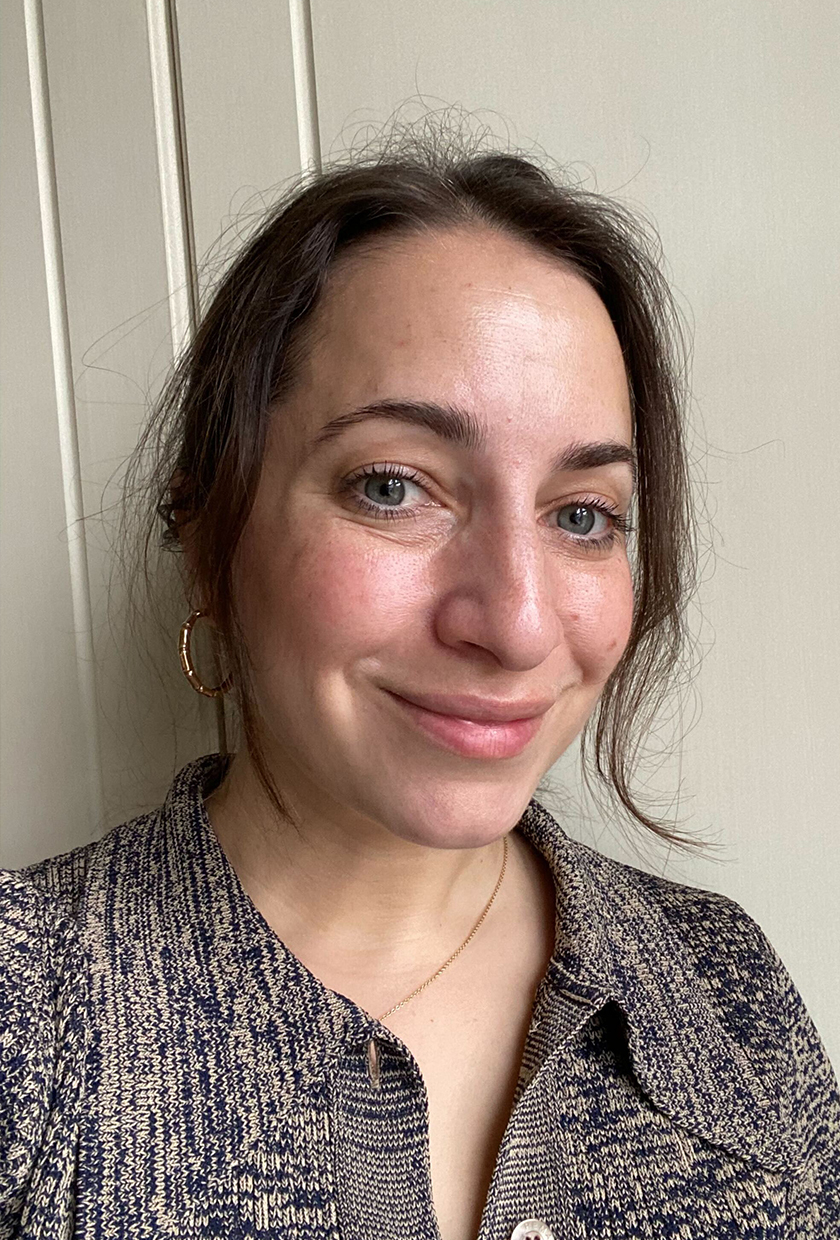
Overall, I feel like my skin is brighter, softer and some of my fine lines have started to lessen ever-so-slightly, but I’m fairly convinced that it would improve over time if I could use the mask multiple times a week (forever!) I like that the settings are in 10-minute bursts, so you can easily fit this into a busy schedule. I stepped up my usage to 3-4 times a week rather than the initial suggestion of two, simply because I had a shorter period of time to test this product within.
I’m a little bit claustrophobic so I knew the feeling of the mask itself might make me a little uncomfortable no matter its design, but it’s easy to breathe in and the stretchy head strap with velcro fastenings means it can adjust to you—this is more of a stiff plastic mould in comparison to some of the rubbery, flexible masks that feature elsewhere in this article. As someone with a larger Middle Eastern nose (for which I am grateful to my Iranian heritage), I found that the mask would leave red indents and a little discomfort after longer periods of use, but it was nothing that would put me off using it. It's worth noting that this is not a rechargeable device but one that allows you to be about 1.5m maximum away from a plug socket.
After

The fact that this is a multi-tasking LED device definitely puts it in a league of its own—there are very few facials you’d have on the regular that combine both anti-ageing and acne treatments, for example. So the fact that you can target multiple issues in one sitting is pretty incredible. Is it good value for money? Well, I can’t deny this is an eye-wateringly expensive piece of kit to invest in, but if you’re someone who spends a lot of money on skincare and the upkeep of your appearance, and would like to take a little bit more of that into your own control and own home, then I think it’s worth investing in. Am I sad to have to send it back to the press office? Absolutely. Any moment of calm and self-care that also brings results, be it physical or mental, is welcome in my world.
9. Dr Dennis Gross Skincare DRx SpectraLite EyeCare Max Pro Device
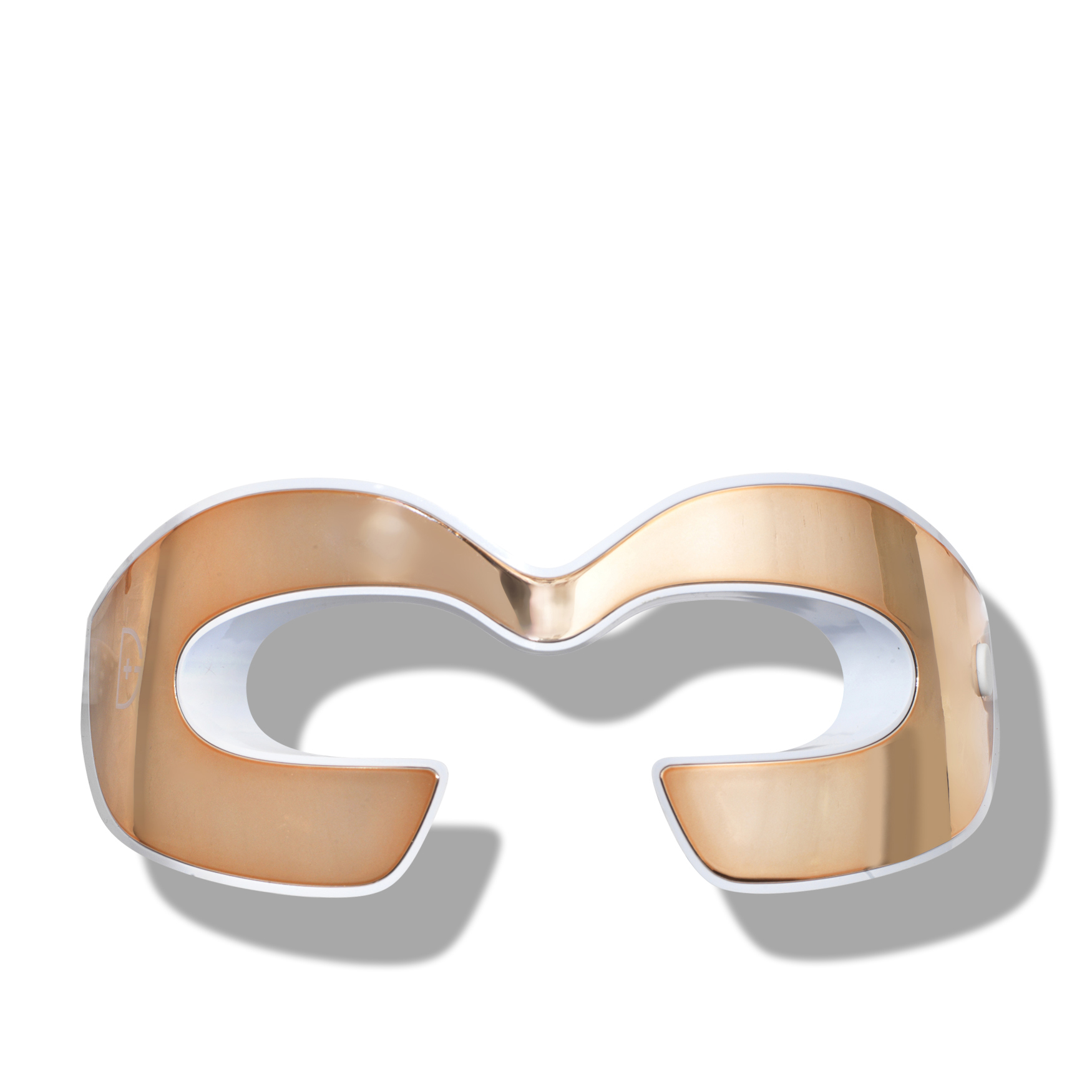
Pros
- Helps to treat eye area
- Reduces wrinkles, puffiness and dark circles
- Quick treatment time
Cons
- Only treats the eye area
Mask type: Moulded eye glasses
Treatment time: 3 minutes
Light specs: 4 wavelengths— amber, red, deep red and near-infrared
Rating: 8/10
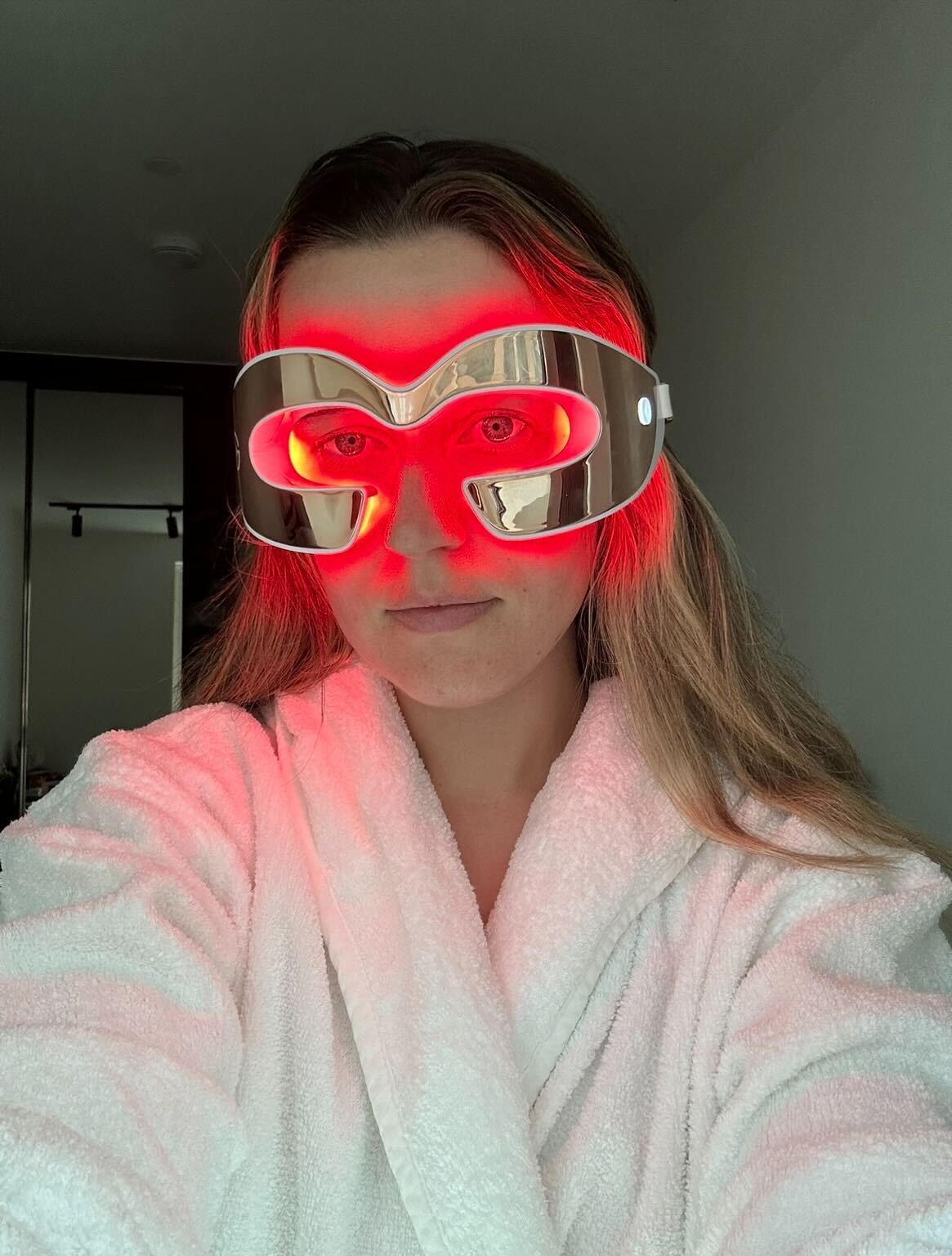
Anyone who knows me will know just how much I love my Dr. Dennis Gross LED mask, so I was very excited to give the LED eye mask version a go. This tool looks just as chic as the full-face version, with four different wavelengths, a hands-free design and a quick and easy three-minute treatment time.
Before

This eye mask is just as good as I expected. It is so simple to set up, and the three-minute treatment time means that it's easy to slot into my evening skincare routine. Each wavelength is emitted during the treatment to tackle a wide range of skincare concerns, and after a few weeks of using I have already noticed subtle differences in my appearance.
After
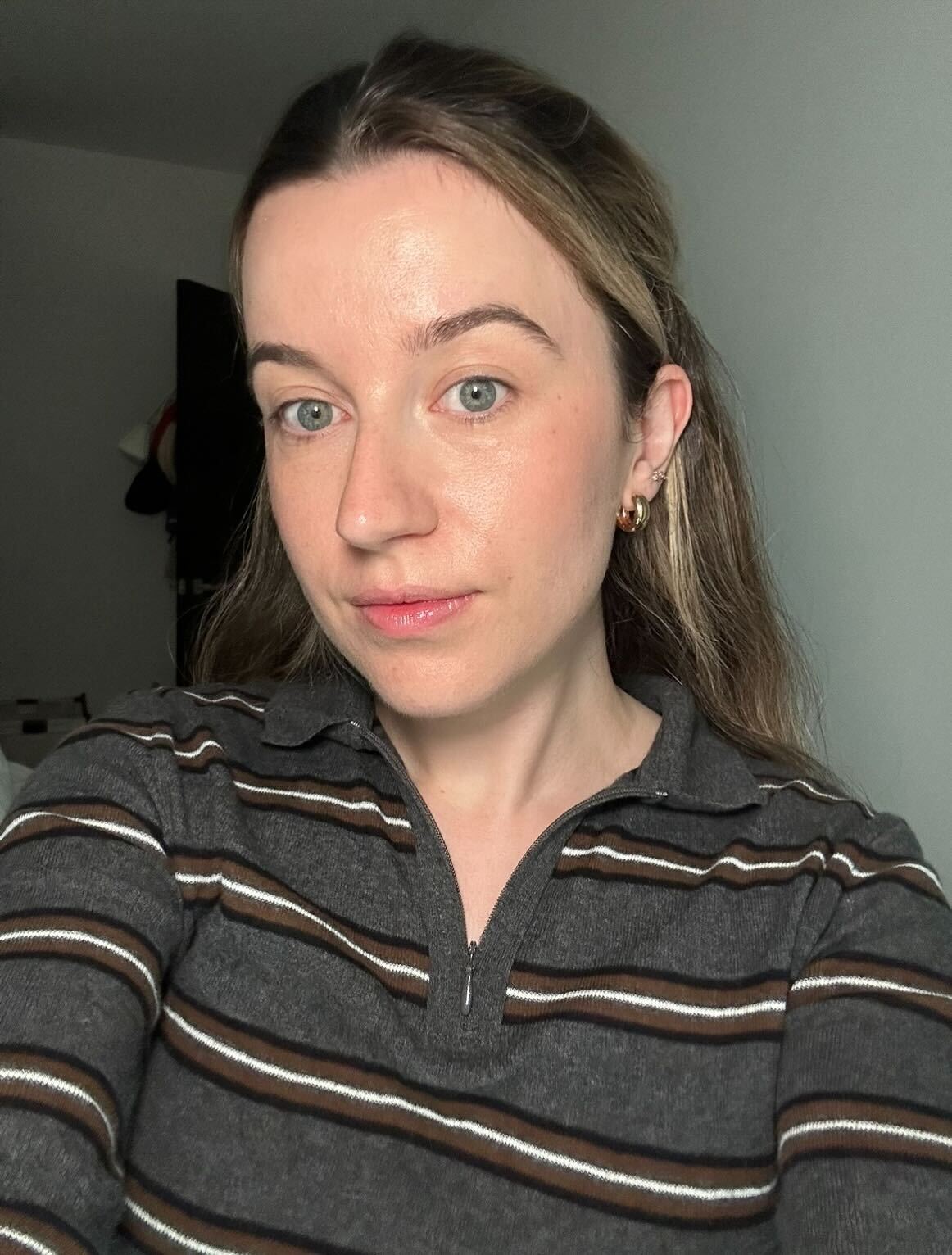
My eye area looks brighter and more awake, and the skin around my eyes already feels firmer and plumper. I don't know if this is a side effect of the LED treatment, but my under-eye concealer also seems to be sitting better on my skin. I am so excited to continue using this beauty tool, and have already recommended it to my mum and my sister-in-law.
10. The Light Salon Boost LED Face Mask
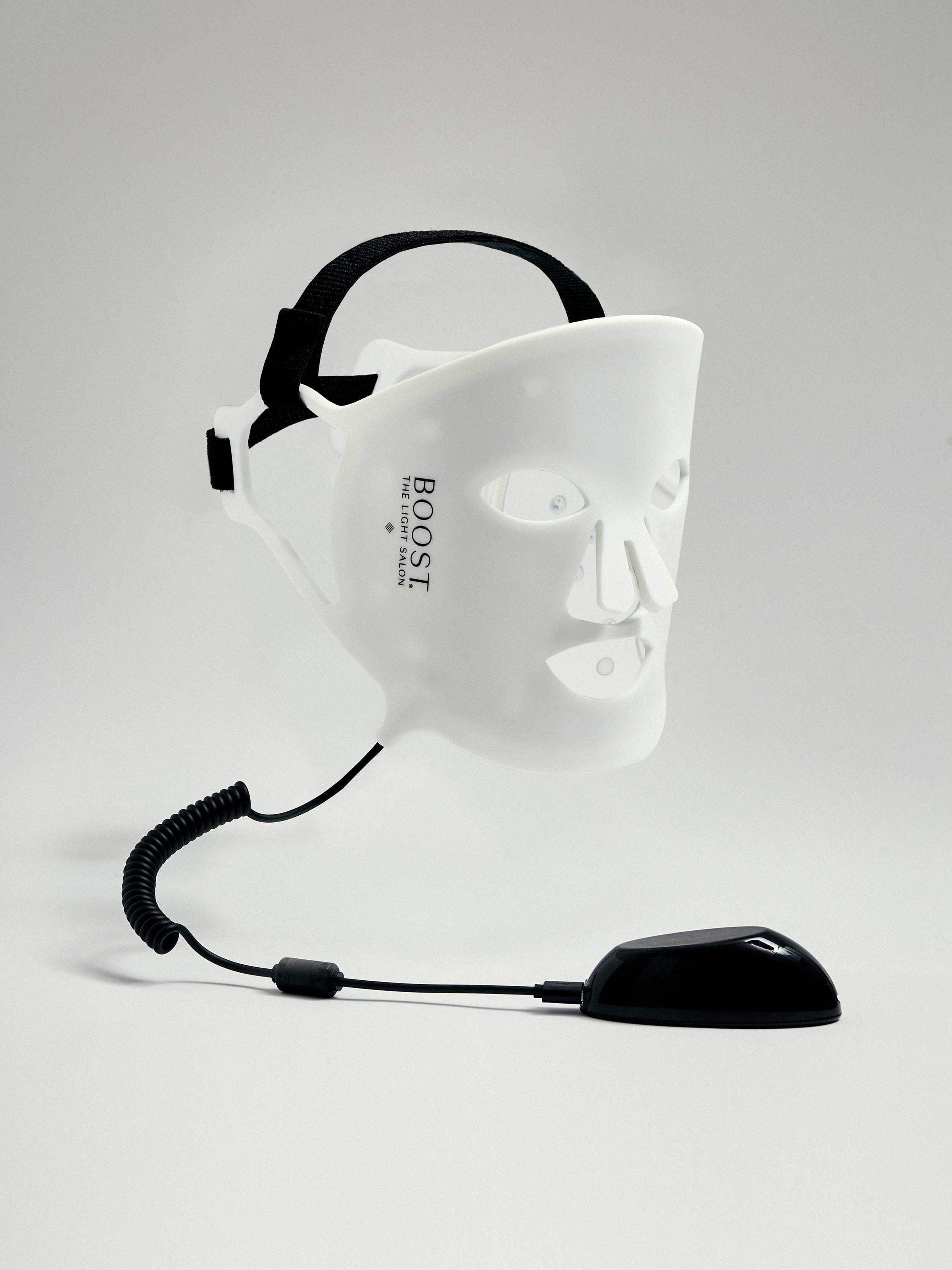
Pros
- Helps to plump and reduce redness
- Red and near-infrared light
- Flexible material moulds to the face
Cons
- More expensive than other LED masks
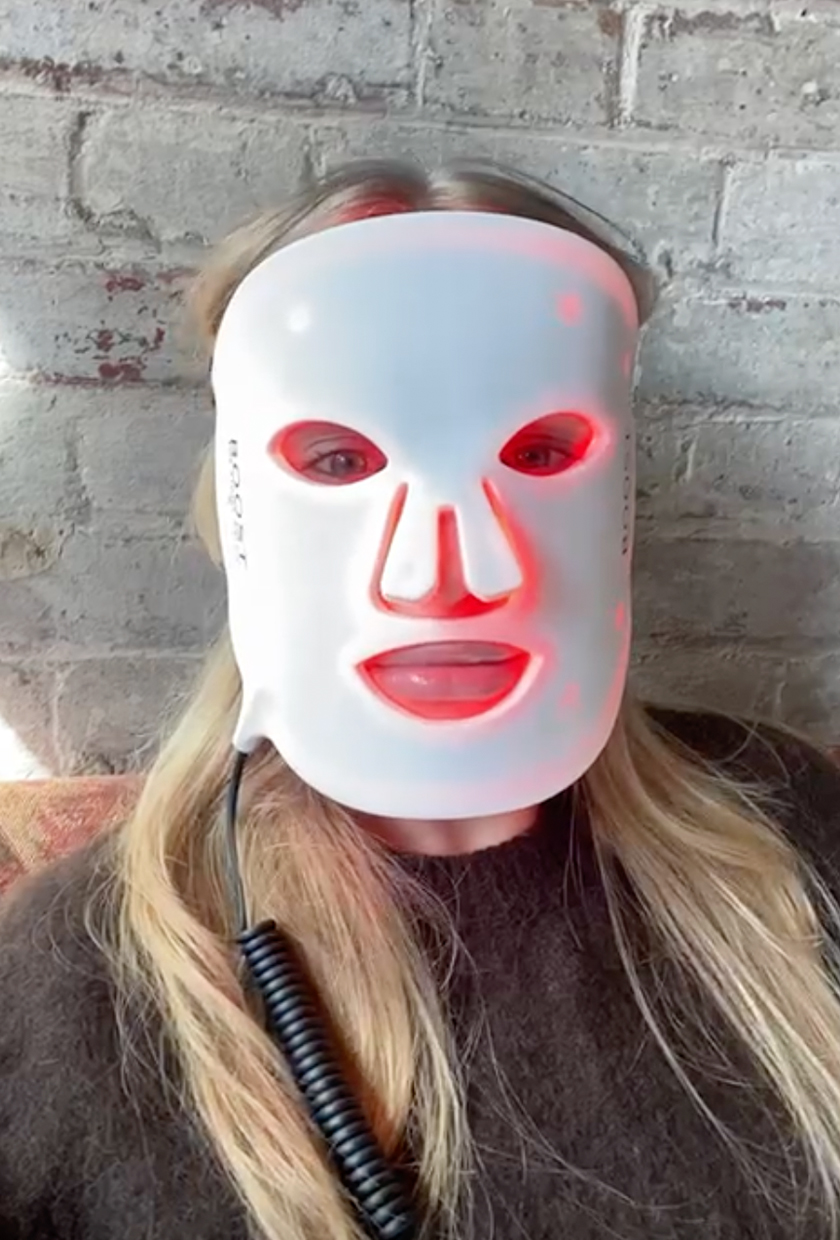
Mask type: Flexible mask, wireless
Treatment time: 10 minutes
Light specs: 2 wavelengths—red (633nm) and near infrared (830nm)
Rating: 10/10
Our verdict: The Light Salon LED mask is very easy to use, there is only one setting, and it automatically turns off after 10 minutes. It emits both red and near-infrared light, which helps reduce inflammation and helps the regeneration of skin cells.
Before
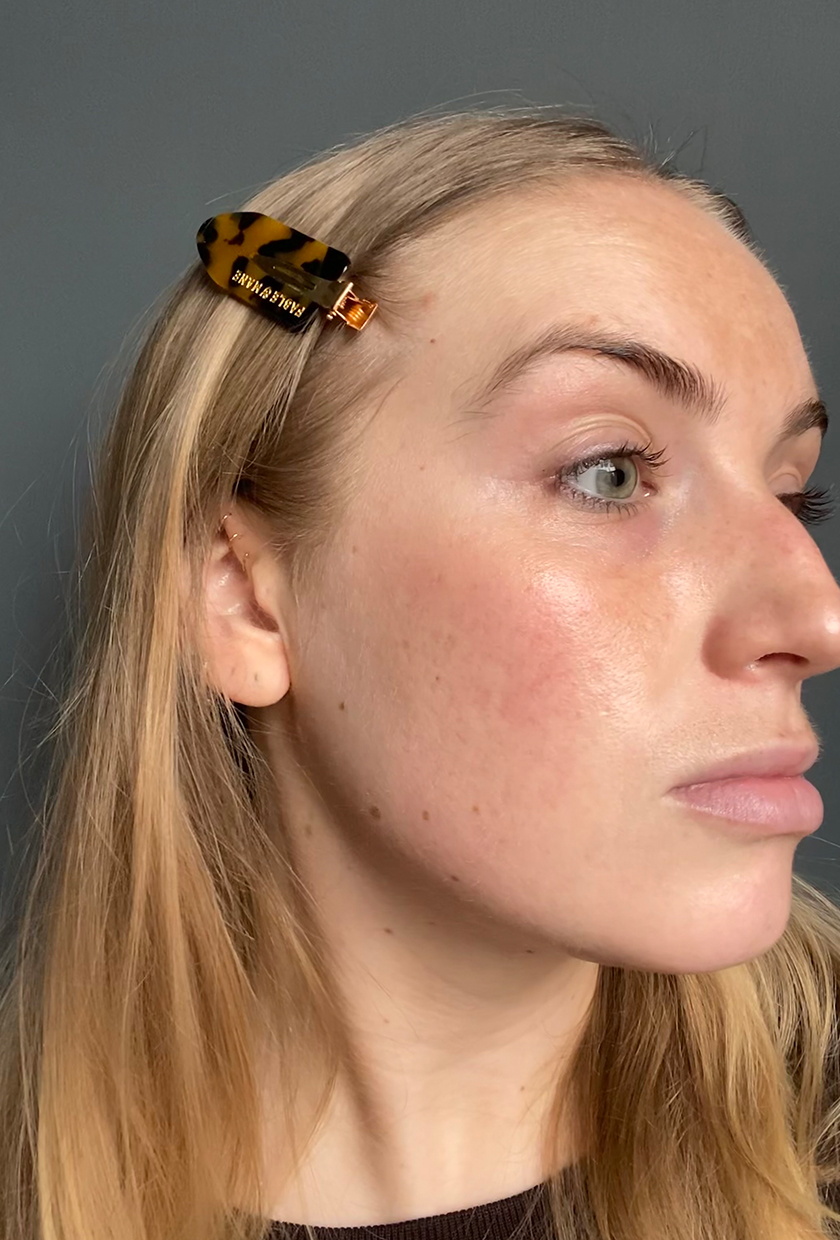
The mask is made from soft and flexible silicone, so it sat comfortably on my face with two straps to secure it in place. One thing that people comment on with LED masks is that the red light can irritate their eyes, but I didn’t have any issues with this—I could still read, look at screens and other activities whilst wearing the device. If your eyes do get irritated, there is also a pair of optional eye shields to use.
After the first few nights of using the Light Salon LED mask, I started to feel like my skin was slightly more plump, and it had started to calm some of the redness. Since testing the Light Salon mask, I have had multiple people compliment me on my skin, saying how good it looks, which is the ultimate compliment since I have experienced acne and scarring over the years. My skin looks smoother, brighter and I feel like my complexion has evened out by reducing the redness on my face.
After
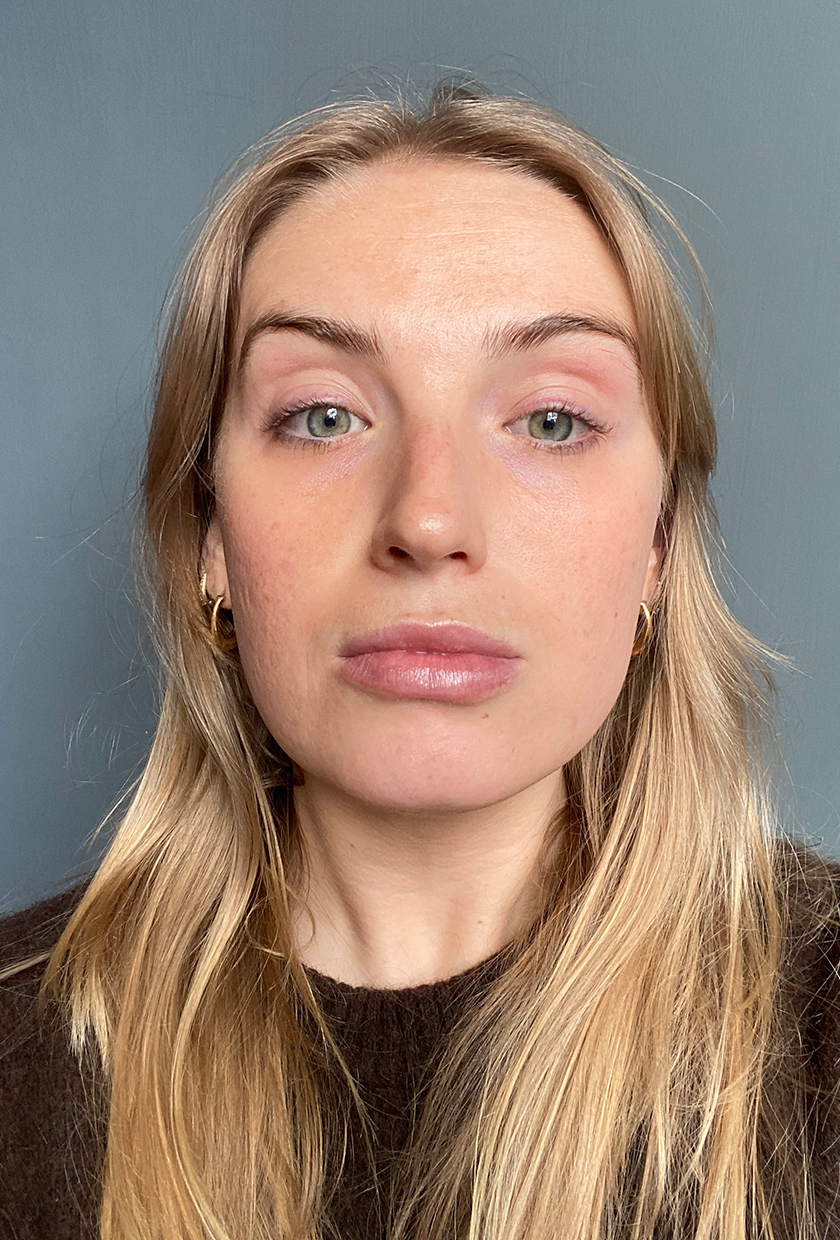
I am a super low-maintenance girl, and I find it hard to stick to products that don’t easily fit into my day, but I found it incredibly easy to add to my nightly routine. Using the device meant that I had 10 minutes at the end of the day to just sit back and unwind, which helped lower my stress levels, and LED can also increase your serotonin levels. It's very compact and comes with global adaptors, so it is perfect to take away on holiday. There is also a lot of charge in the device; I charged it at the start of the trial, and haven’t needed to charge it again, even though I have been using it a minimum of five times a week.
There was nothing that I didn’t like about it; I wanted to use it every day! I am always slightly sad when the light turns off after the allotted 10 minutes. I would definitely buy this product or recommend it to a friend, it is super easy to use and I started to see results straight away. If you are using the product regularly, then the cost of the device is worth it, especially if you go to salons for LED treatments.
11. MZ Skin Light-Therapy Golden Facial Treatment Device
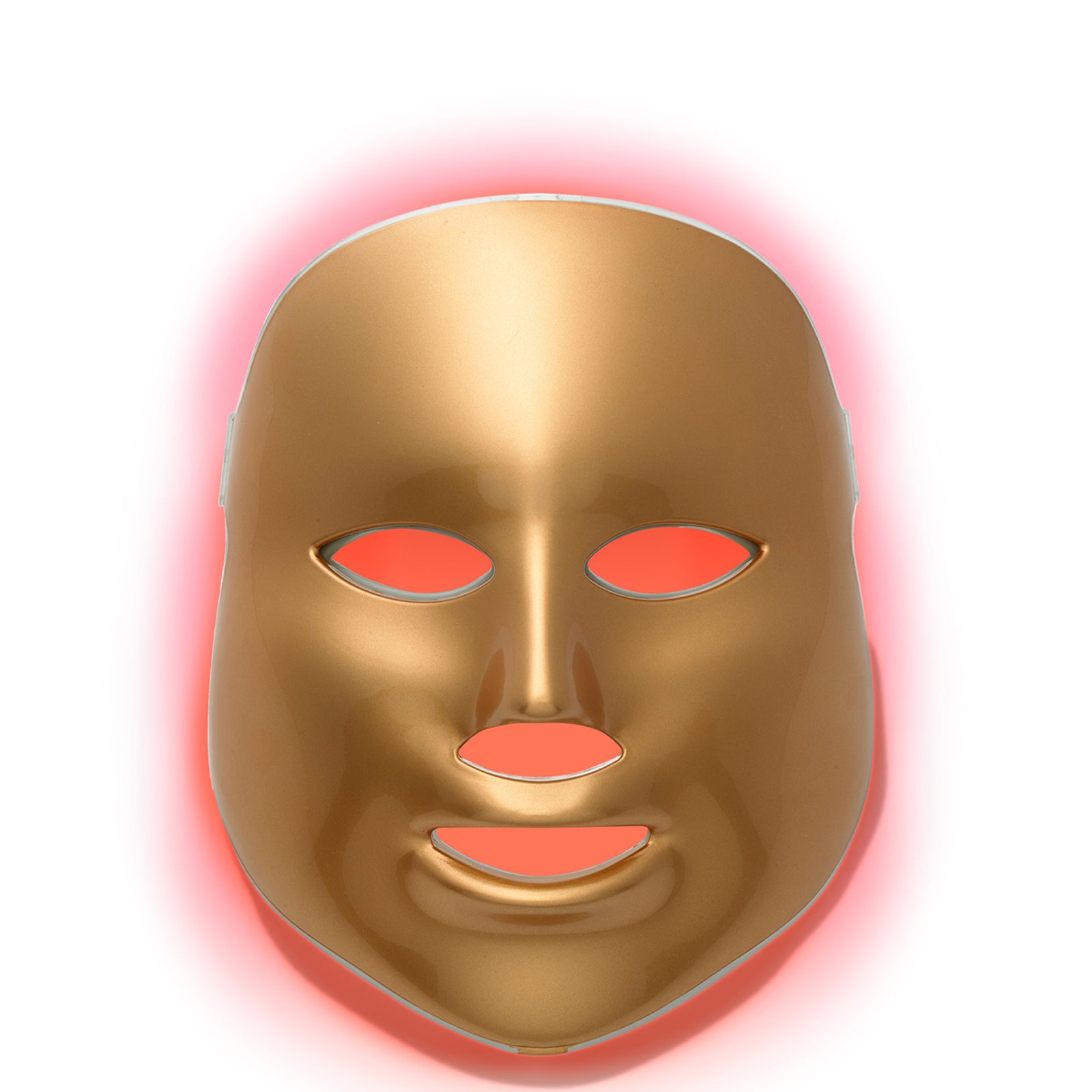
Pros
- 5 different wavelengths, including red, green, blue, white and yellow
- Increases collagen, calms skin, reduces redness and inflammation , increases skin repair
- Luxurious design and feel
- Tailored treatments and treatment timings
Cons
- Can leave indents on skin after use
- More expensive than most LED masks
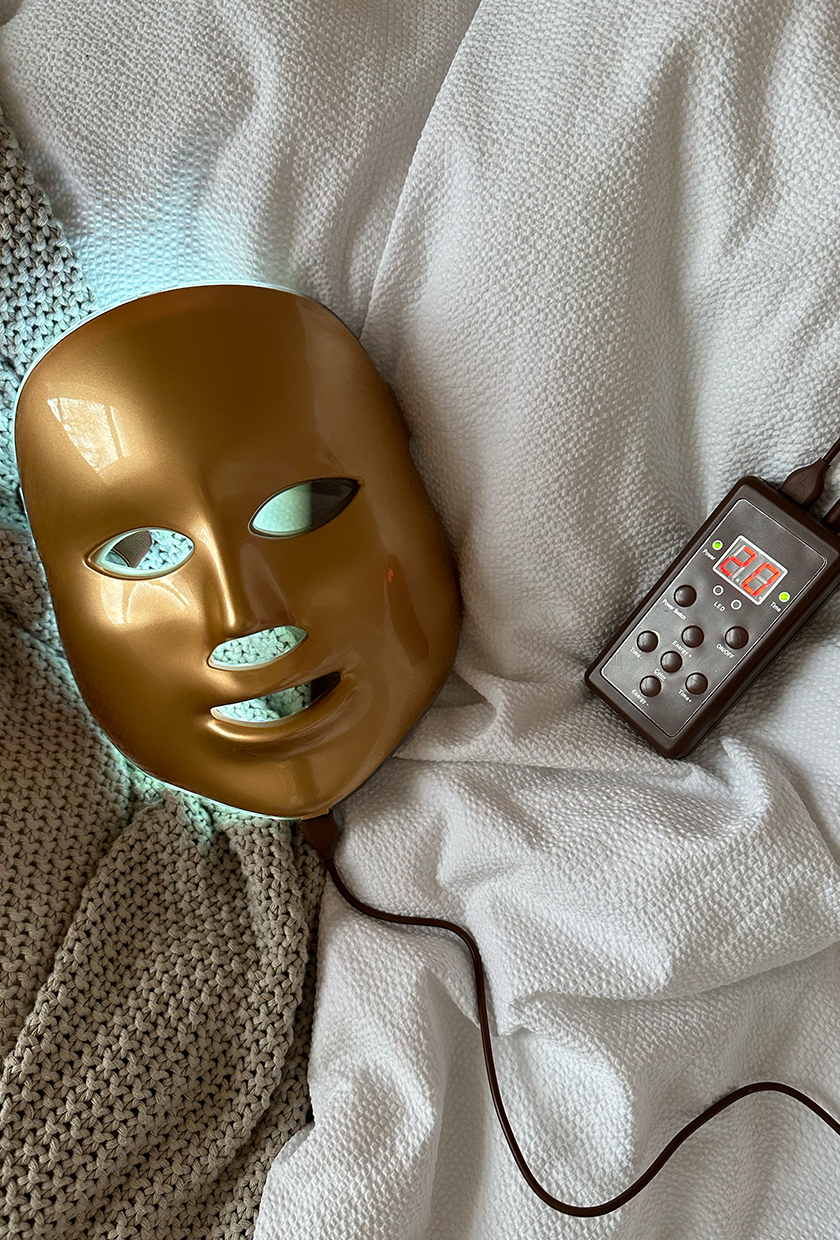
Mask type: Mask with strap, mains connection
Treatment time: 10-20 minutes
Light specs: 5 wavelengths—red (630nm), blue (430nm), green (520 nm), yellow (570-590nm), and white (450-460nm)
Rating: 7/10
Our verdict: As far as our panel of testers goes for this round of Deep Reviews, MZ Skin really drew the short straw with me. I want to be transparent before we go any further, as during the timeframe we were each reviewing our LED devices, I was pretty run-down. I'm in the fortunate position to be renovating a house, but that comes with its own unique set of stresses. With my usual routine being virtually non-existent—cue weeks of missing the gym and consuming what feels like more processed foods than I have in the past 33 years of my life combined—the £500 MZ Skin Light-Therapy Golden Treatment Facial Mask sure had its work cut out.
Before
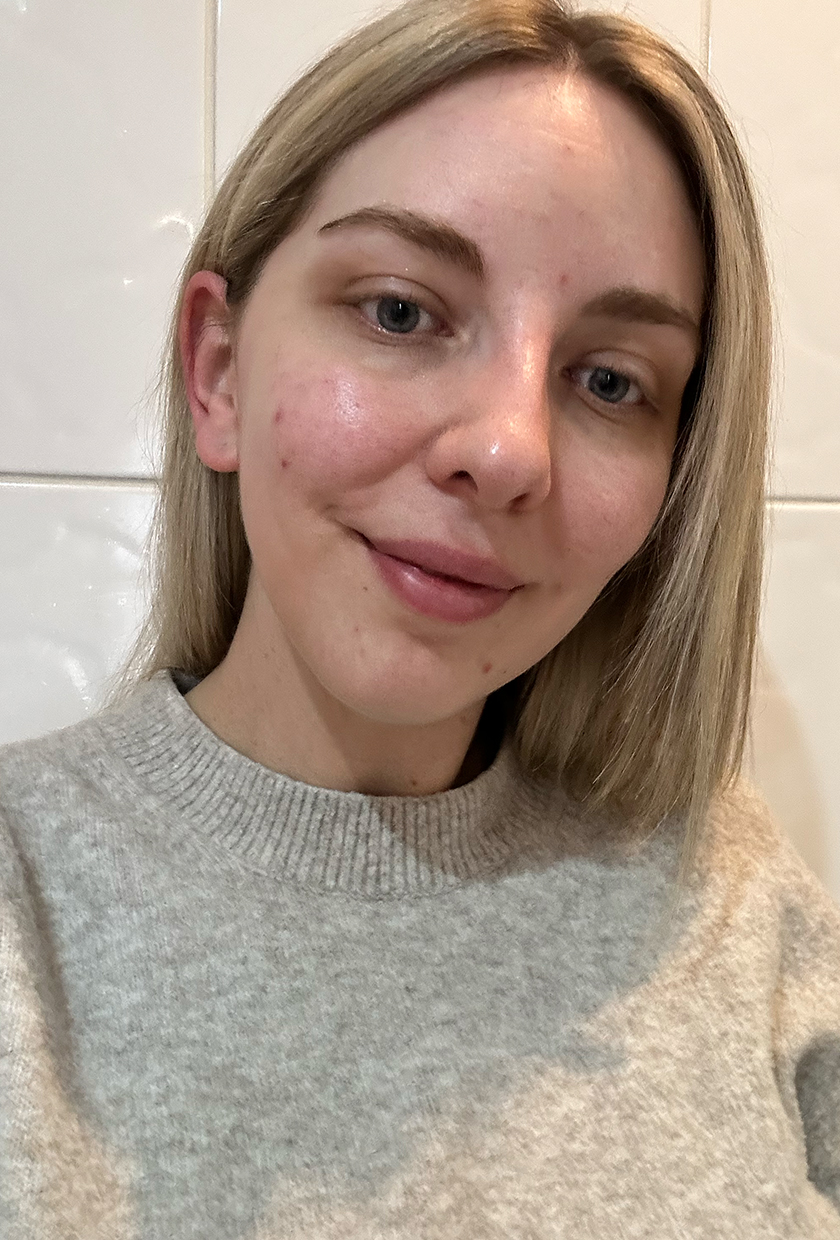
The mask has a total of five coloured LED light settings, each of which provides a different targeted treatment. Having read up on them, I opted to use the red light throughout the duration of my trial. According to the MZ Skin website, this treatment "has profound anti-ageing benefits, it stimulates collagen and elastin production and strengthens skin. This light setting also reduces inflammation, heals blemishes, repairs sun damage and improves scarring.” Sounds good, right?
In addition to the red-light therapy I decided upon, the MZ Skin Light-Therapy Golden Treatment Facial Mask also features four more settings: blue light, which balances and clarifies the skin, treating acne and, with repetitive use, improves blemished skin. Green, which calms skin and reduces pigmentation, broken capillaries and sunspots. Yellow, which reduces redness and boosts circulation (this setting is ideal for sensitive skin as it boosts lymphatic flow and soothes). And, finally, white, which penetrates deeply to promote wound healing and skin repair. I like how easy it is to tailor your sessions, be it five minutes or twenty-five minutes, on the lowest setting of 1 or the highest setting of 5, as well as the selection of different colour therapies you have at your disposal in one mask.
I’m the sort of person who responds to rules, so I followed those on the box stringently. MZ Skin advises applying the LED mask to cleansed, dry skin. Use two to three times per week, starting with 10 minutes of LED mask time and slowly building up to 20 minutes. I did so, starting on a low setting (I started out on two and built my way up to four and five). As for first impressions, I’d seen the MZ Skin mask doing the rounds on Instagram; its luxurious gold face piquing my interest. Indeed, the mask itself feels substantial and durable—it certainly feels premium.
Before I embarked on this at-home light-therapy course, my usually clear skin was in turmoil; I put this down to hormonal changes as well as experiencing a reaction to the washing powder used on the sheets in our temporary rental accommodation. I was also pretty sleep-deprived. So, the first positive reaction I saw was the simple act of carving out the downtime to enjoy my light-therapy session. Even on the weakest setting for the shortest amount of time, the light is very bright, and it is advised you keep your eyes closed for the duration of wearing the mask, which I gladly obliged. First use over, and I didn’t see any results, but I did feel relaxed.
After
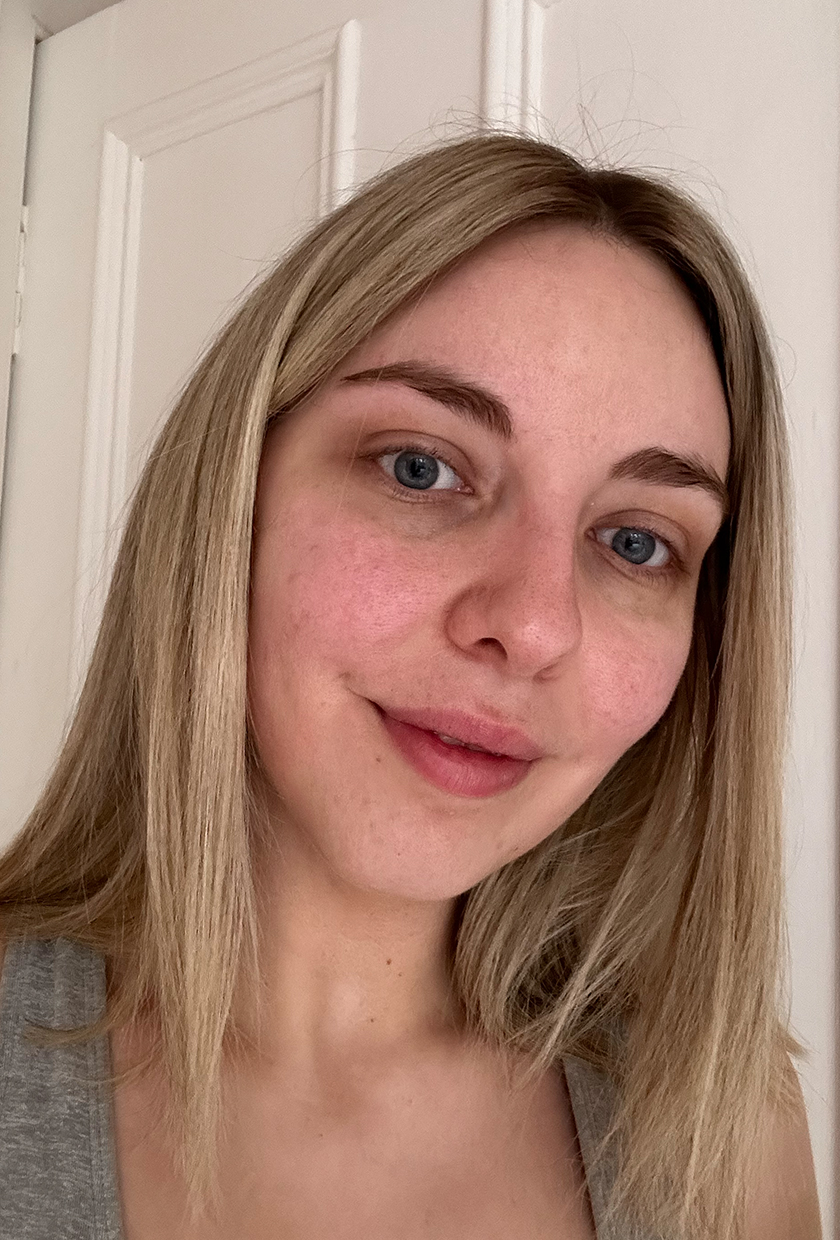
As you can see, my blemishes have entirely disappeared. Whether that’s down to switching back to my usual laundry detergent, the MZ Skin mask, or a combination of both, I’m not entirely sure. Either way, my confidence is up! I had been hoping the red-light therapy would help even out my skin tone, but perhaps this wasn’t the best setting for that. I do, however, feel as if my skin is firmer and plumper, which were some of the promised benefits of the red-light setting. My face feels tauter and I could be wrong, but my fine lines do appear to be slightly minimised, too. I imagine this is one of those beauty products that you only really realise its benefits when you stop using it, so I’ll be very interested to see how my skin is looking in two weeks' time. In an ideal world, I’d retry the mask when my life is more settled (and I’m not sleeping on an airbed for the fourth week in a row).
Wearing the mask presented some issues, but they may be isolated—hear me out. I was sent a press sample to try for a month, with the agreement of sending it back after the trial. My exact mask has likely been used and reviewed by several different people, but I was disappointed when I realised the clasp didn’t work. This meant I could only use it when I was lying flat on my bed. I didn’t think this was a big deal until I realised that, especially as I upped the frequency and timings, the sheer weight of the mask itself was creating impressions in my skin, which would take at least an hour to subside.
Actually, looking at my "after” photograph, which was taken after ramping up my mask usage, I’d say doing so has made my eye bags look more pronounced. As I say, the mask I was using had likely been handled by several people, so some wear-and-tear is expected, but I would urge you to check your clasps upon purchasing to make sure they work as they should, so you can wear it as designed. I do, however, think the mask is well contoured and the edges are smooth throughout its inside. I like how easy it is to tailor your sessions, be it five minutes or twenty-five minutes, on the lowest setting of 1 or the highest setting of 5, as well as the selection of different colour therapies you have at your disposal in one mask.
At £500, this would easily be the most expensive item in my beauty arsenal if I did. However, as someone who is relatively happy with their skin 99% of the time, I probably wouldn’t buy it. But, then again, I wouldn’t buy another LED mask in its place! Who knows—in a couple of weeks, when its effects have worn off, I might find myself on the MZ Skin website, bank card in hand. I’ll keep you posted.
How Does LED Work?
"LED stands for Light Emitting Diodes, and they work through a process called phototherapy where the LEDs emit certain wavelengths of light into your skin to stimulate biochemical reactions, such as re-energizing cells and stimulating collagen production, says aesthetic doctor, Hany Abi Ghosn. "It’s a non-invasive and completely natural process for treating a variety of skin concerns and conditions."
What Are the Benefits of LED?
According to Abi Ghosn, LED masks that use red and near-infrared light can reduce signs of ageing skin such as fine lines, wrinkles, pigmentation (especially from sun damage), uneven skin texture and tone. "A mask with blue light can be used to treat acne by killing acne-causing bacteria," he adds.
Which Colour Light Is Best for Me?
"If your concerns are anti-ageing focused, you’ll absolutely want to use a device that has both red and near-infrared at the optimised wavelengths," explains Abi Ghosn. "The best wavelength for treating acne-prone skin is blue light (415nm) as it can neutralize and kill p. acnes bacteria in the skin if you combine this with red (633nm) light to reduce inflammation and redness, it’s a wonderful way to naturally treat breakouts."
Is LED Harmful?
"The wavelengths of light used in LED light therapy (ie, 415nm, 633nm, 830nm+) are outside of the harmful UVA and UVB wavelengths on the light spectrum," explains Abi Ghosn. They do not cause UV damage or cancer."
Why Trust Us
AtBest Knockoff Luxury Clothing
UK, we know that beauty isn’t one-size-fits-all. Our editors have tested thousands of products, including skincare, makeup, hair and nails, over the years and work closely with trusted experts—dermatologists, make-up artists and leading industry insiders—to ensure every guide is well-researched, inclusive and relevant to you.
We focus on formulas that deliver, whether they’re affordable favourites or luxury investments. Our product selection is based on tangible results, ingredient know-how and what we’d truly recommend to a friend.
This story was originally published at an earlier date and has since been updated.

Eleanor Vousden is the beauty editor for Who What Wear UK. She was previously deputy editor at Hairdressers Journal, health writer at Woman
Home and junior beauty editor at Powder. She has also contributed to Wallpaper and Elle Collections.
With a degree in fashion journalism from the London College of Fashion, she has 10 years of industry experience and has been highly commended at the BSME Talent Awards for her work on Powder and also contributed to the title winning Website of the Year at the PPA Awards.
Eleanor’s journalistic focus is providing readers with honest and helpful beauty content. She has interviewed celebrity makeup artists, hairstylists and dermatologists throughout her career, as well as celebrities such as Hailey Bieber, Sarah Jessica Parker and Scarlett Johansson.
-
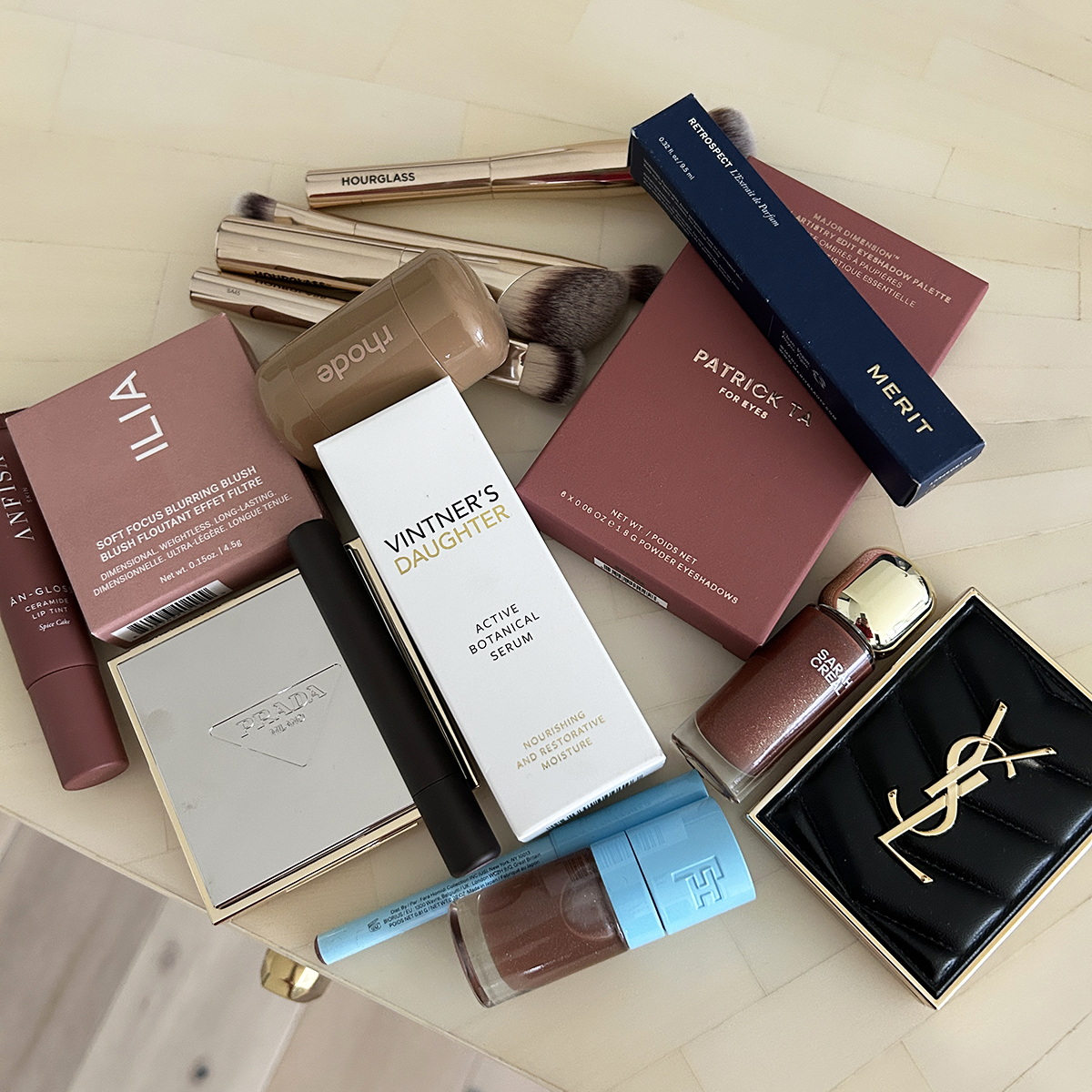 I'm a Fashion Editor—These Are the Beauty Gifts I Want to Give (and Receive) This Year
I'm a Fashion Editor—These Are the Beauty Gifts I Want to Give (and Receive) This YearAs stylish as they are effective.
-
 All the 2025 Beauty Advent Calendars Have Officially Hit the Market—Here Are the Only 20 I Recommend Buying
All the 2025 Beauty Advent Calendars Have Officially Hit the Market—Here Are the Only 20 I Recommend BuyingThese are too good to miss.
-
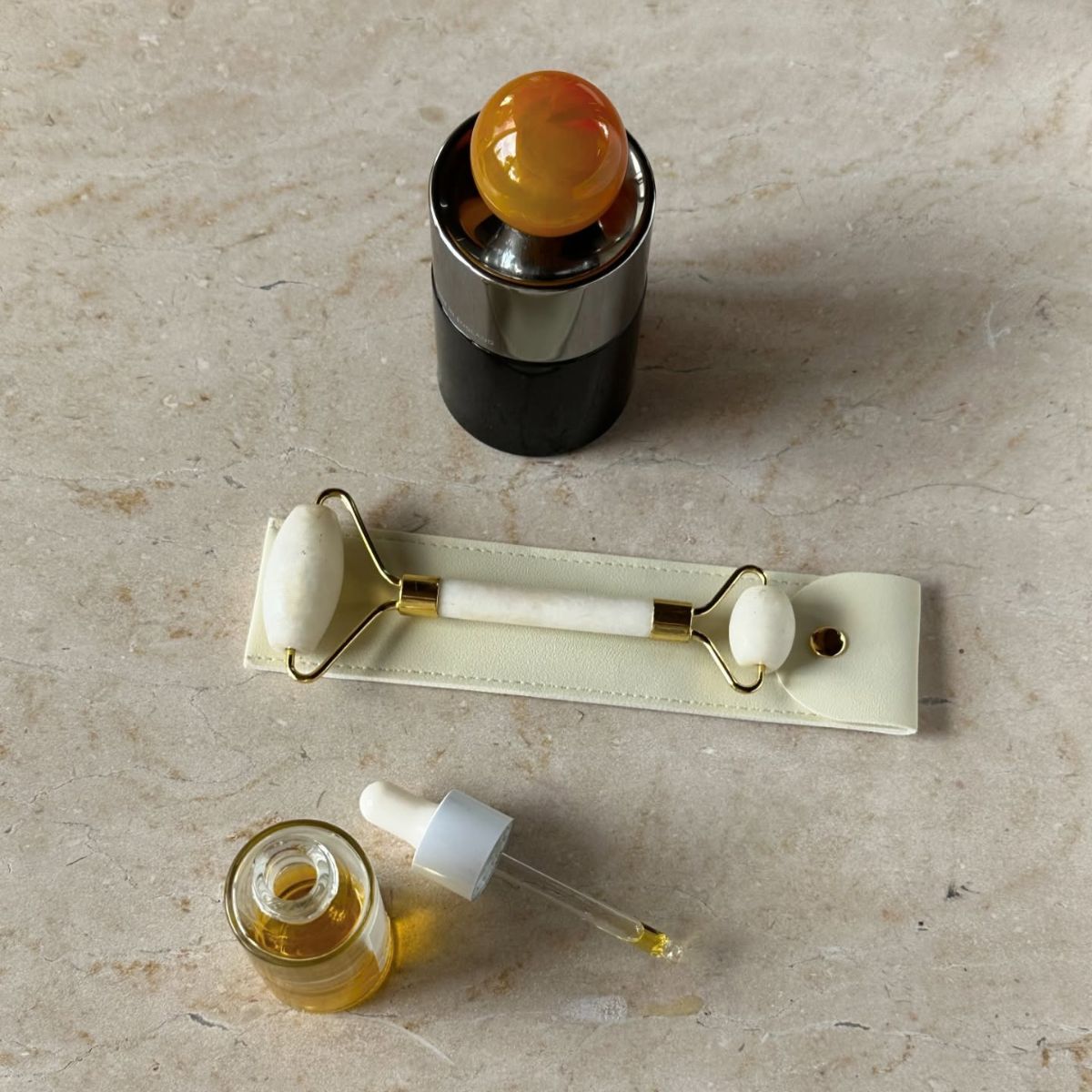 My Mom (53) and I (25) Pored Over Dermstore's Black Friday Sale—16 Items We Both Instantly Added to Cart
My Mom (53) and I (25) Pored Over Dermstore's Black Friday Sale—16 Items We Both Instantly Added to CartDeals on at-home lasers, French beauty, and more saved us $1049.
-
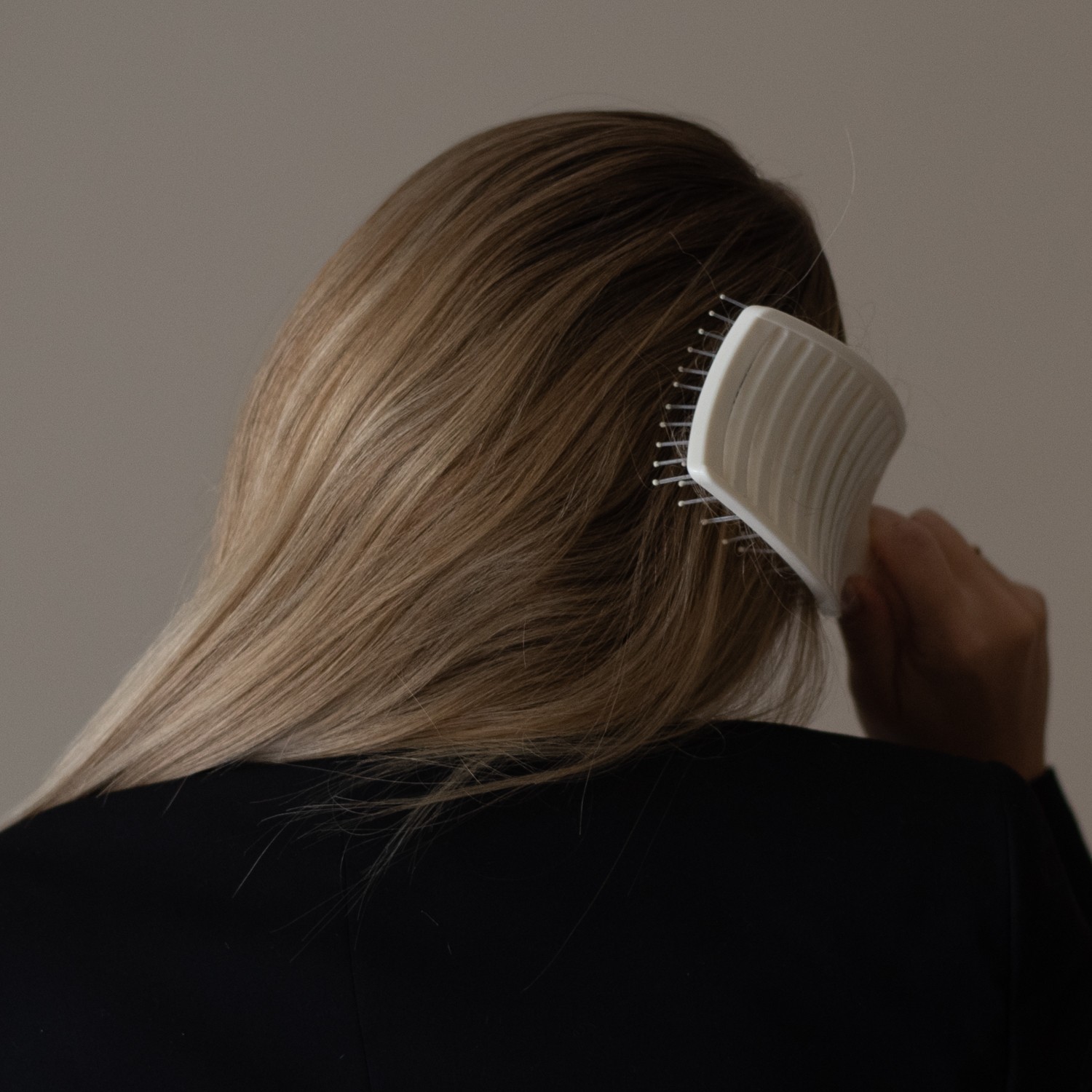 I'm a Beauty Editor With a Penchant for Glossy, "Liquid" Hair—19 Cyber Week Deals I'm Personally Eyeing
I'm a Beauty Editor With a Penchant for Glossy, "Liquid" Hair—19 Cyber Week Deals I'm Personally EyeingTime to give my strands some TLC.
-
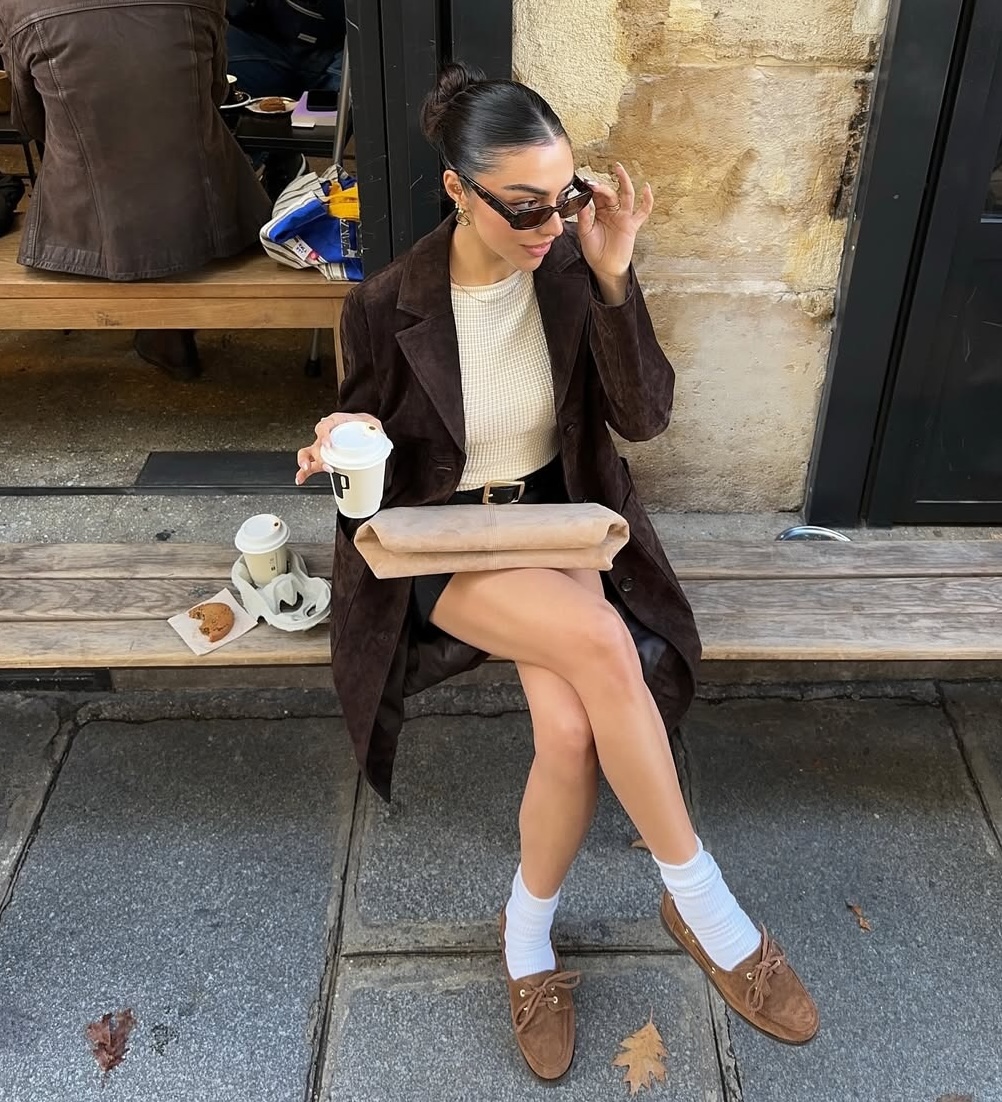 Behold: A Beauty Editor's Guide to the Best Black Friday Deals—the 43 Sales *Actually* Worth Shopping
Behold: A Beauty Editor's Guide to the Best Black Friday Deals—the 43 Sales *Actually* Worth ShoppingYour complete guide. (Thank me later.)
-
 Cardi B Says This Viral K-Beauty Product Presses Delete on Dark Spots, so I Tried It
Cardi B Says This Viral K-Beauty Product Presses Delete on Dark Spots, so I Tried ItTL;DR: It works like a charm.
-
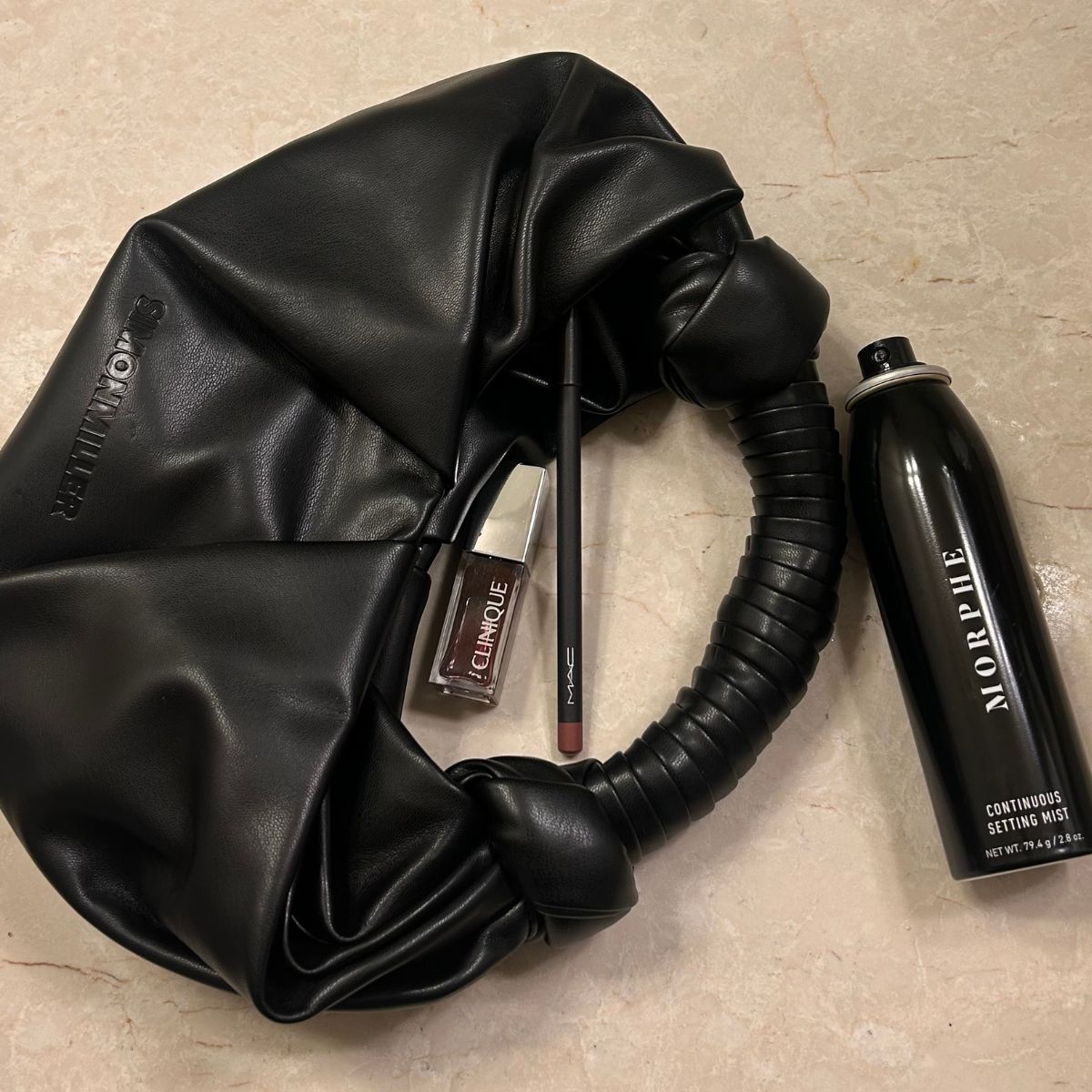 Ulta's Black Friday Sale Just Saved Me $696—I Already Sent These 25 Deals to My Family Group Chat
Ulta's Black Friday Sale Just Saved Me $696—I Already Sent These 25 Deals to My Family Group ChatSol de Janeiro, Marc Jacobs, and Burberry on sale from $13.
-
 Don't Wait—the Hair Gloss That Earns Me Countless Compliments Is Cheaper Than Ever RN
Don't Wait—the Hair Gloss That Earns Me Countless Compliments Is Cheaper Than Ever RNBRB, I'm stocking up.

